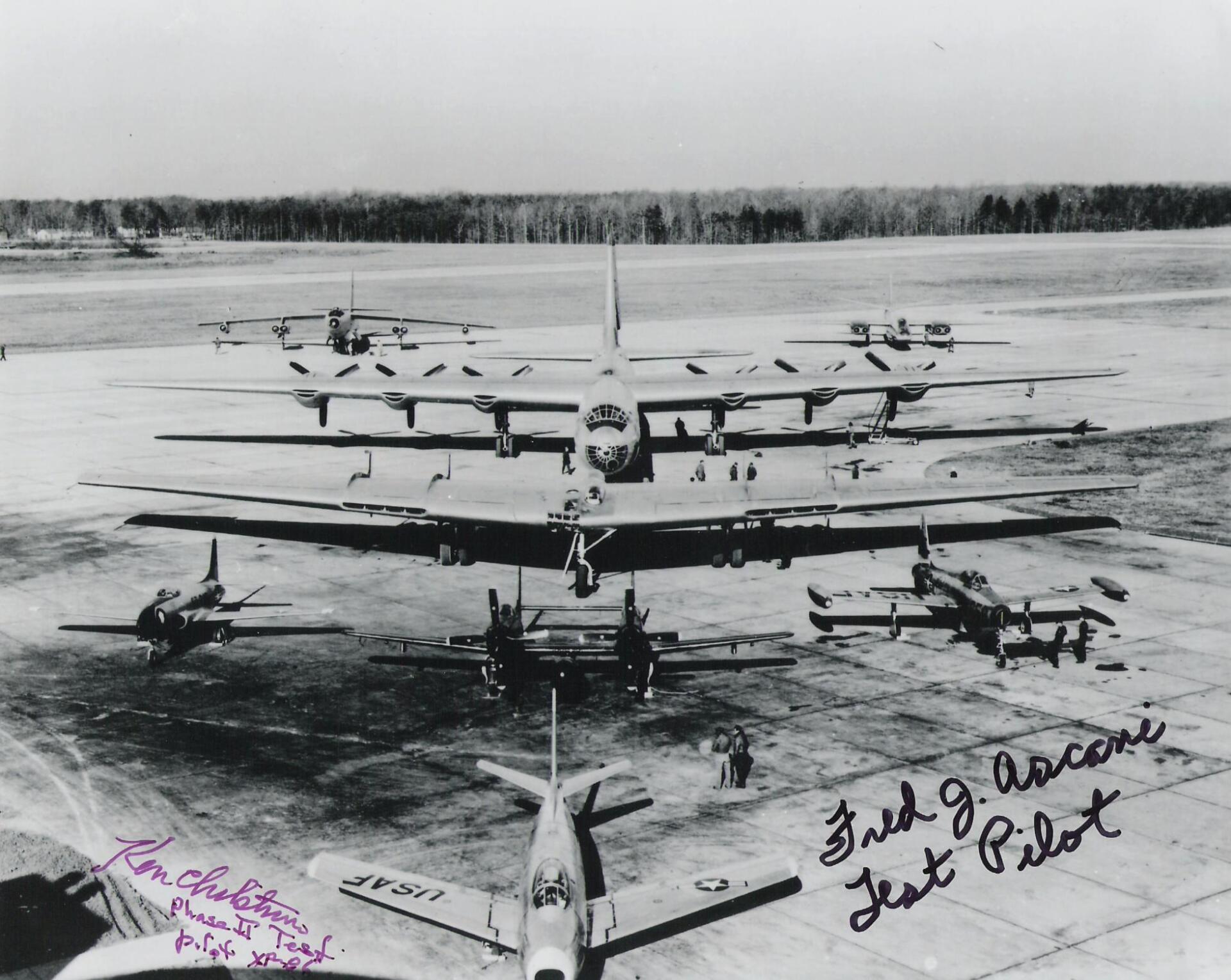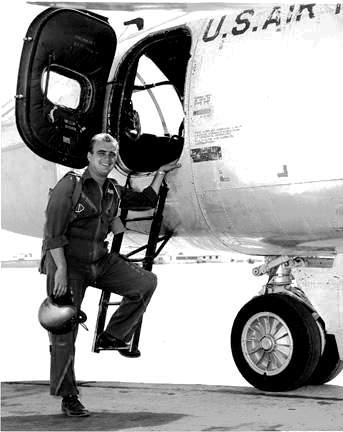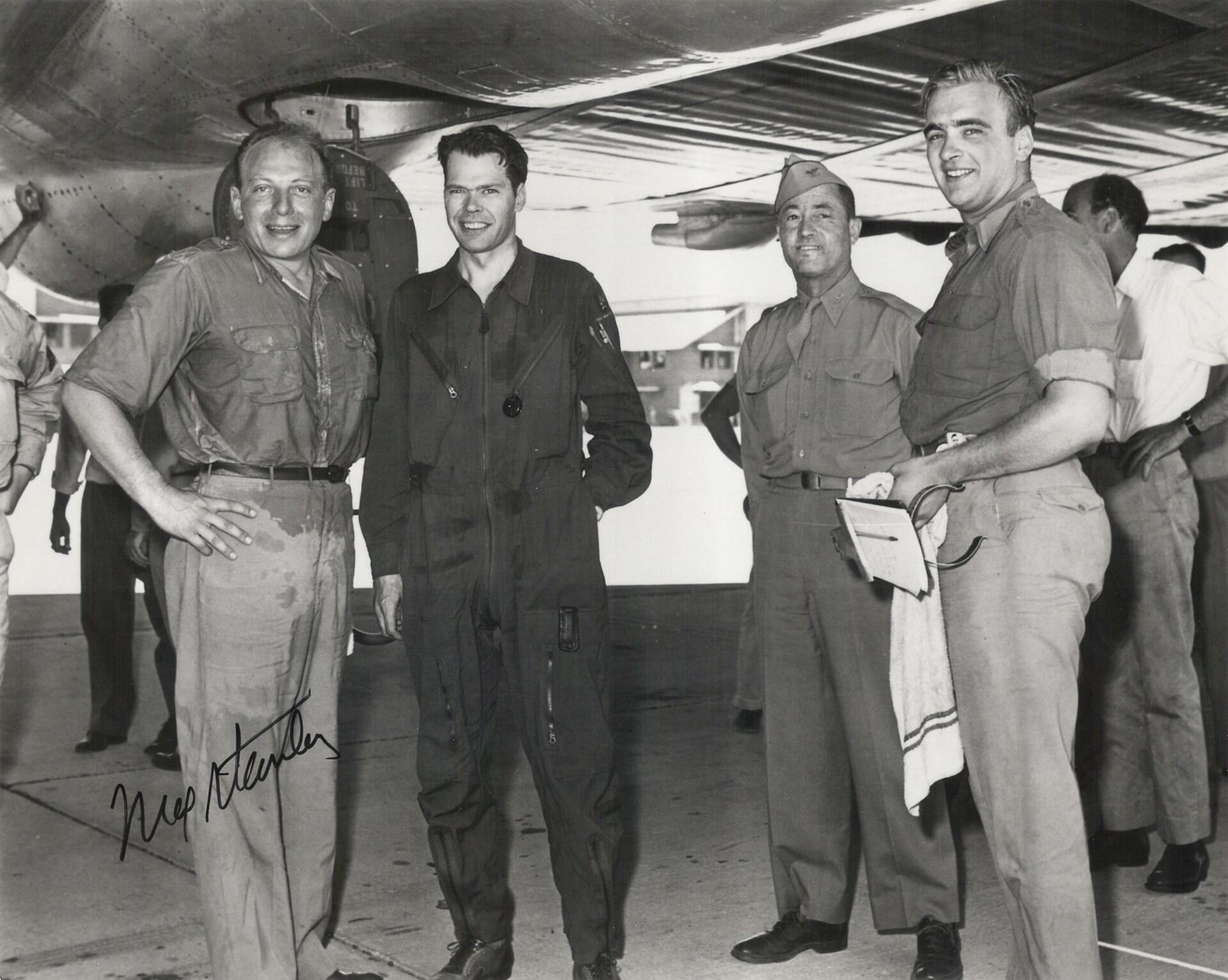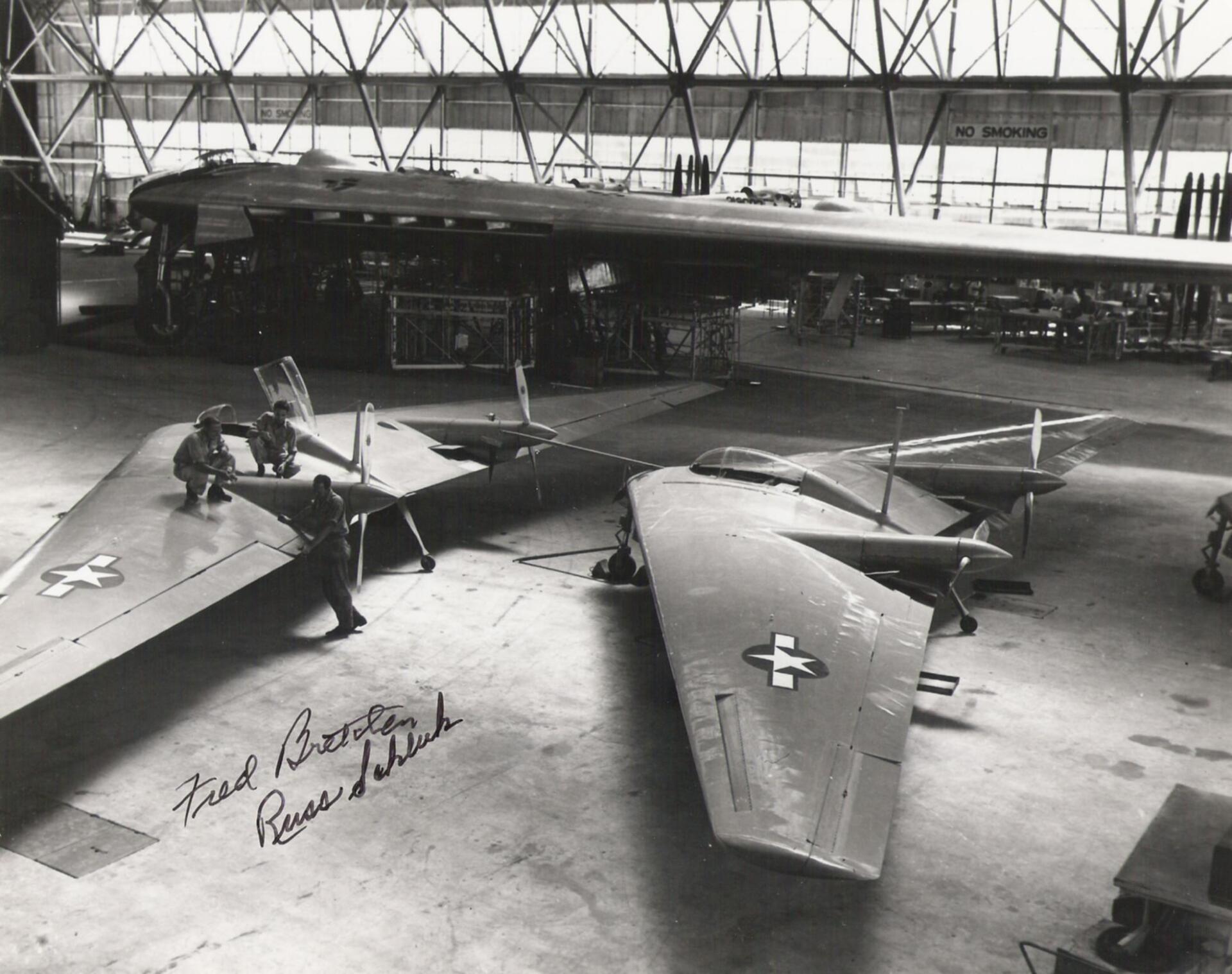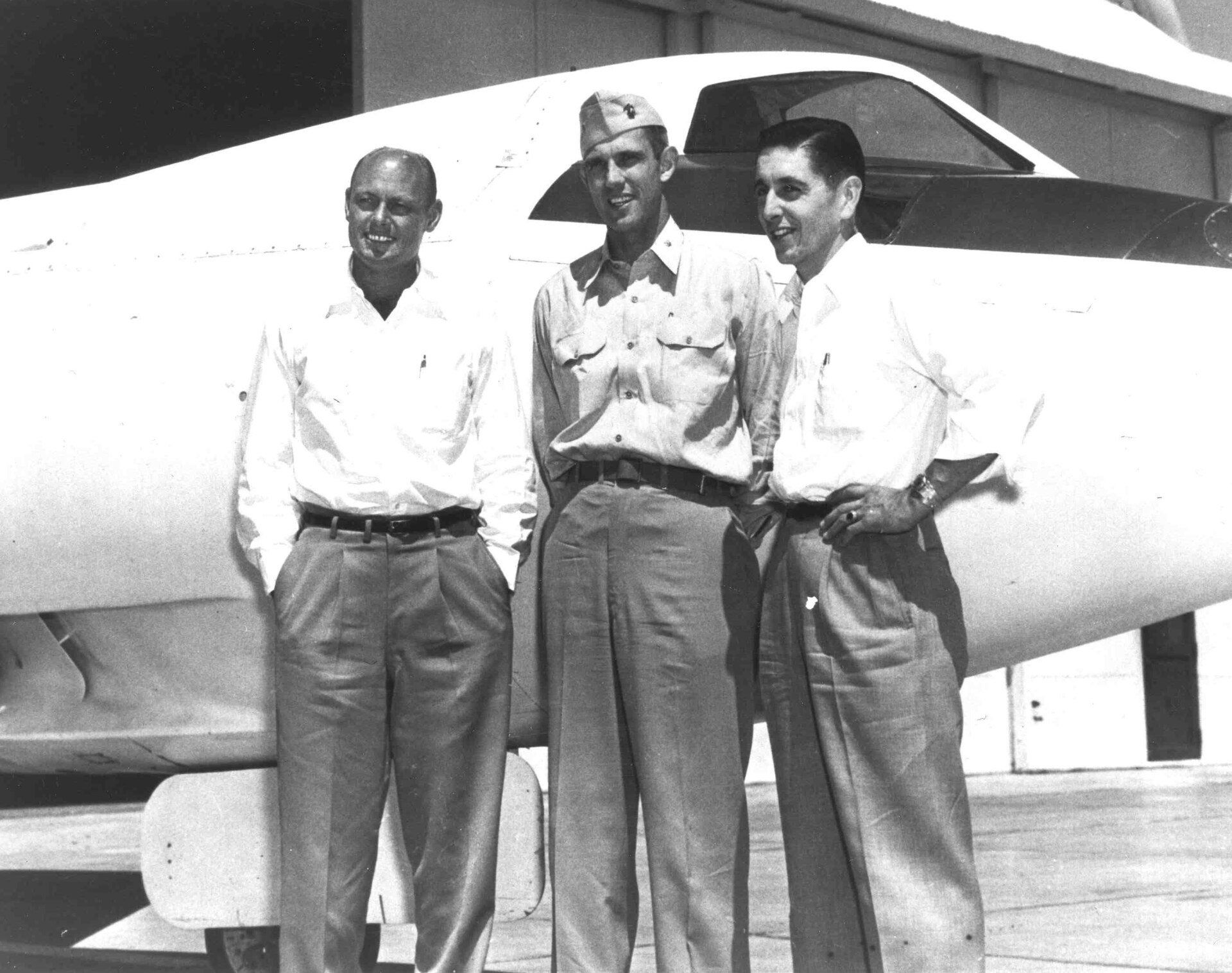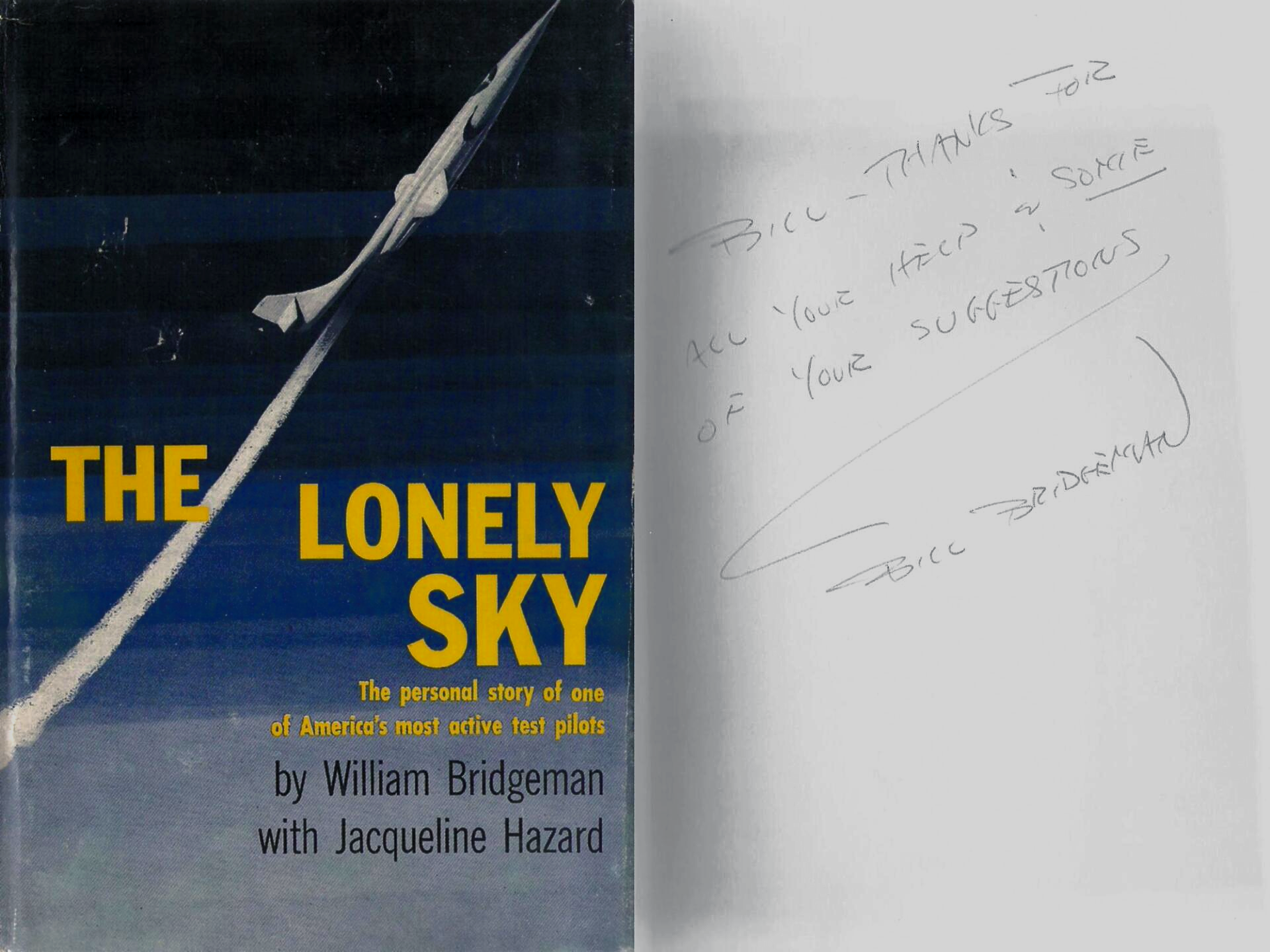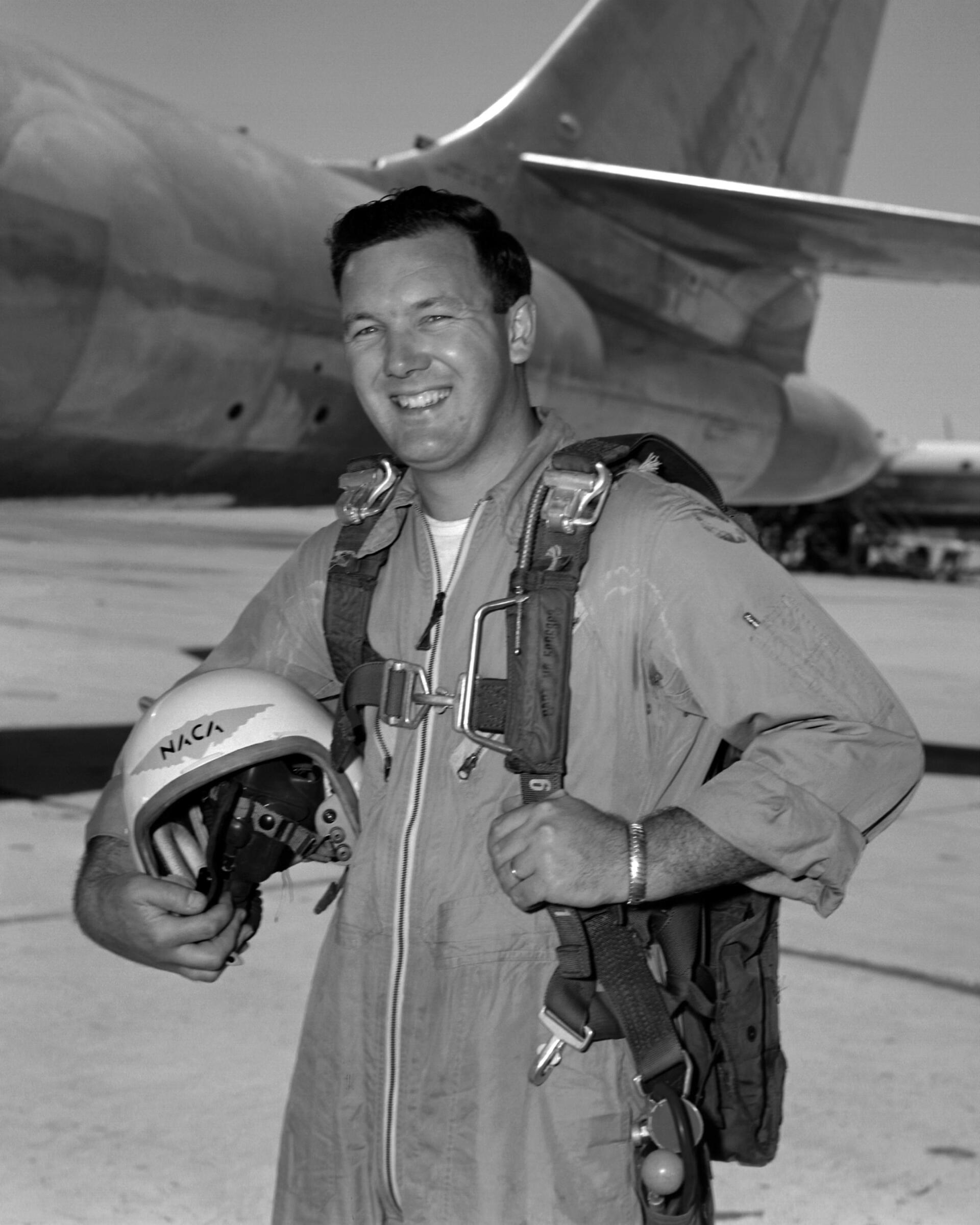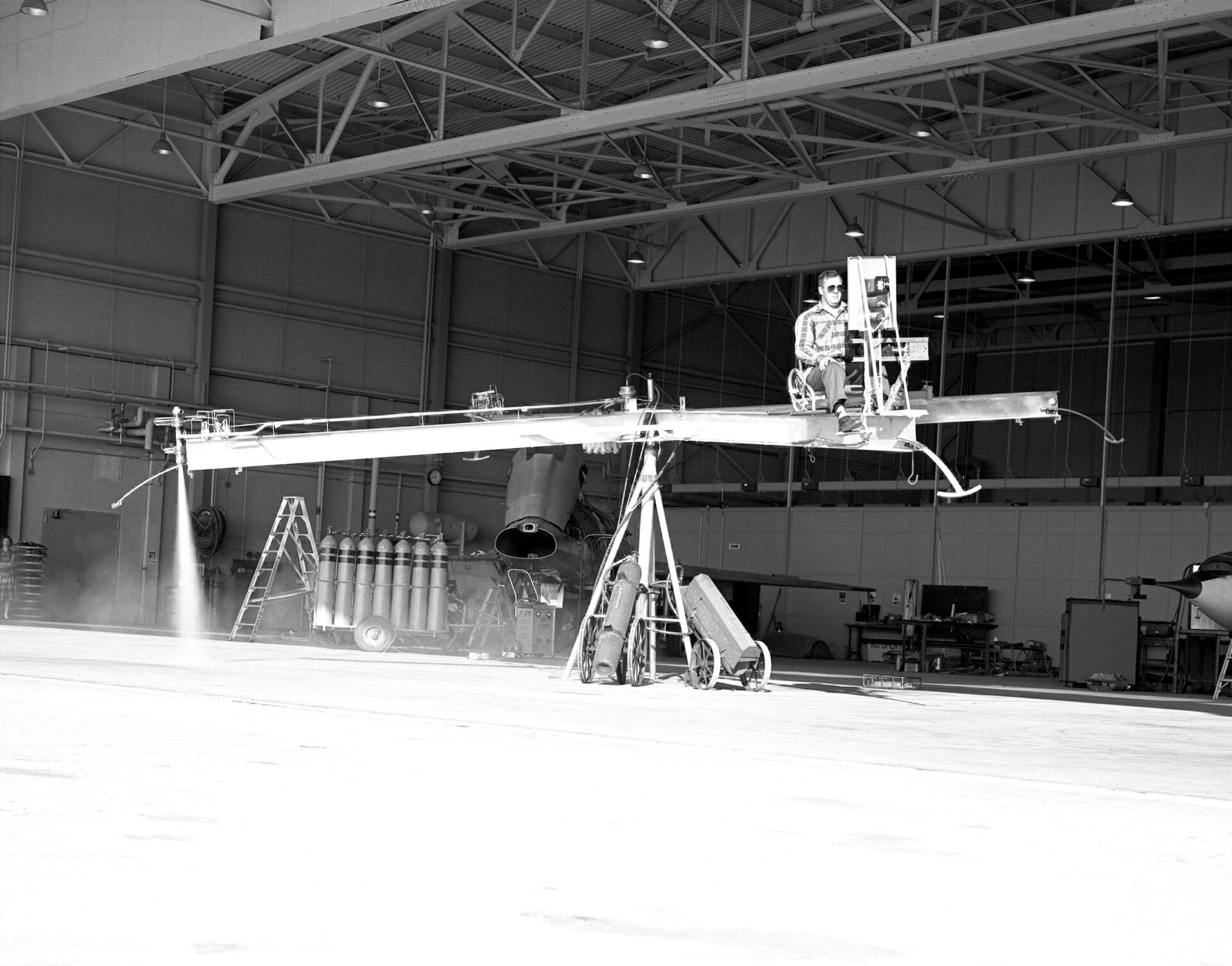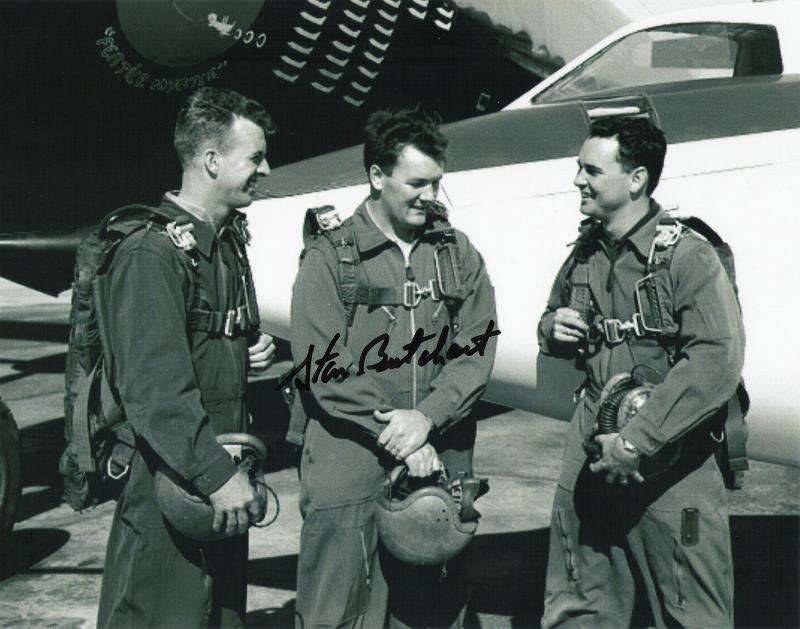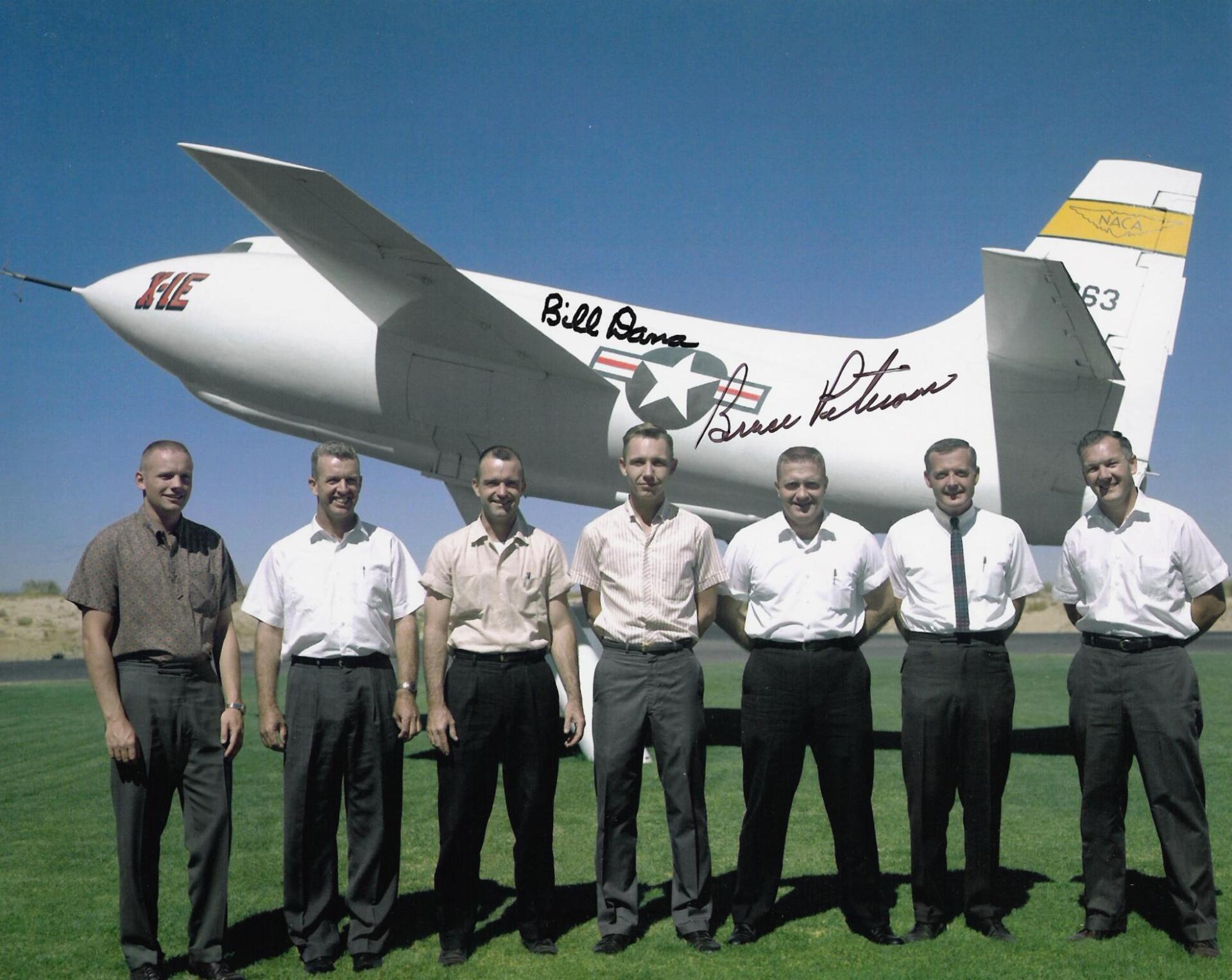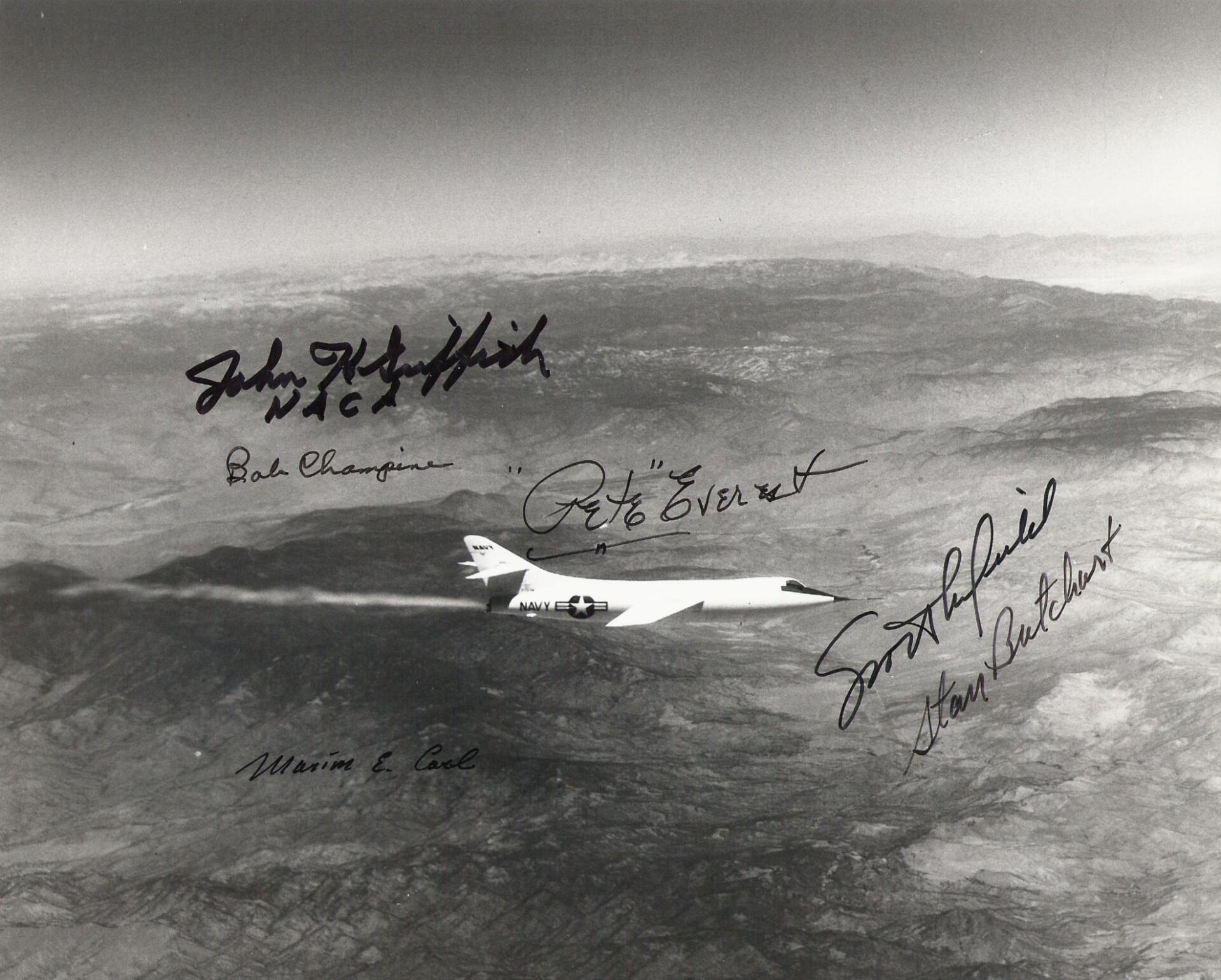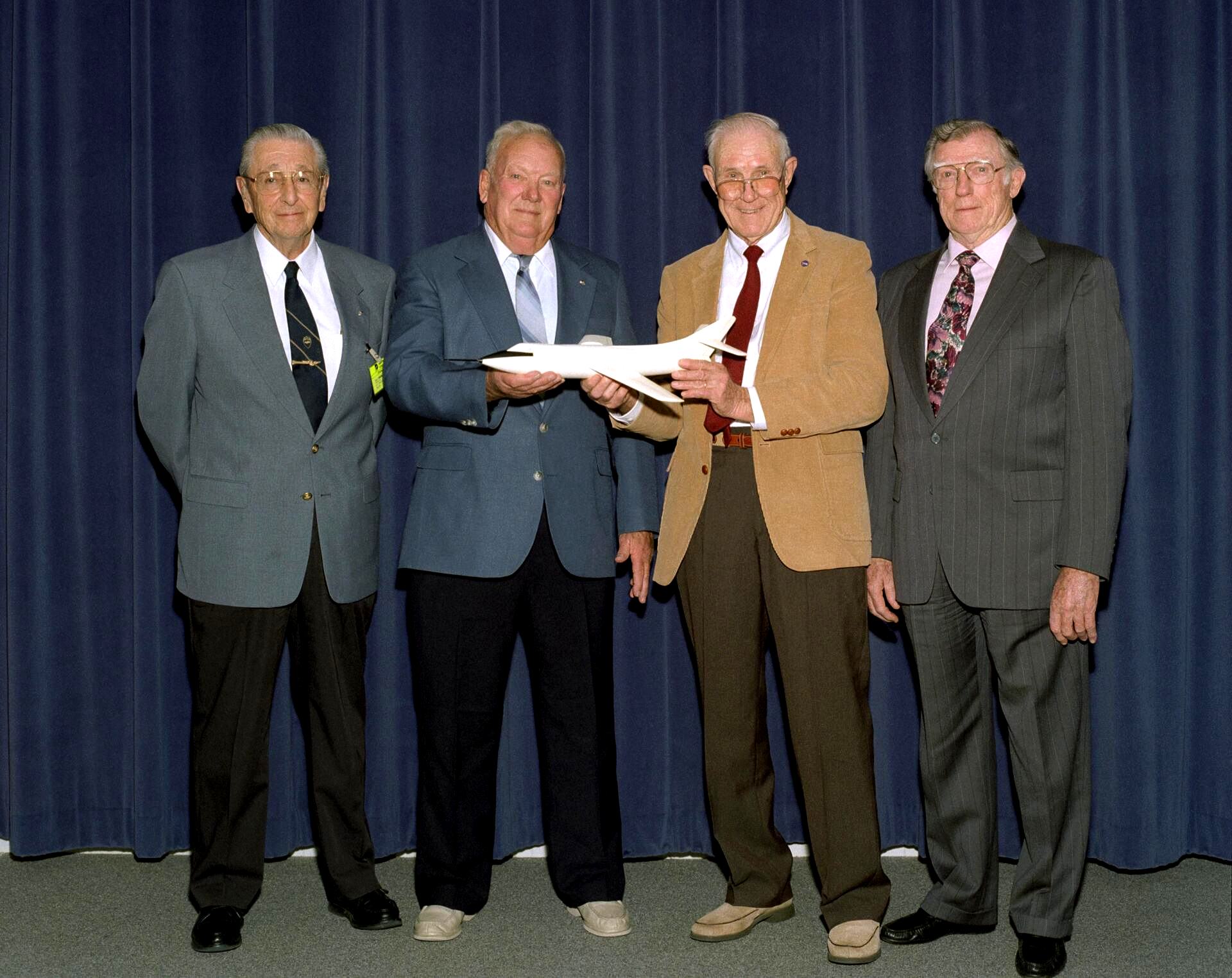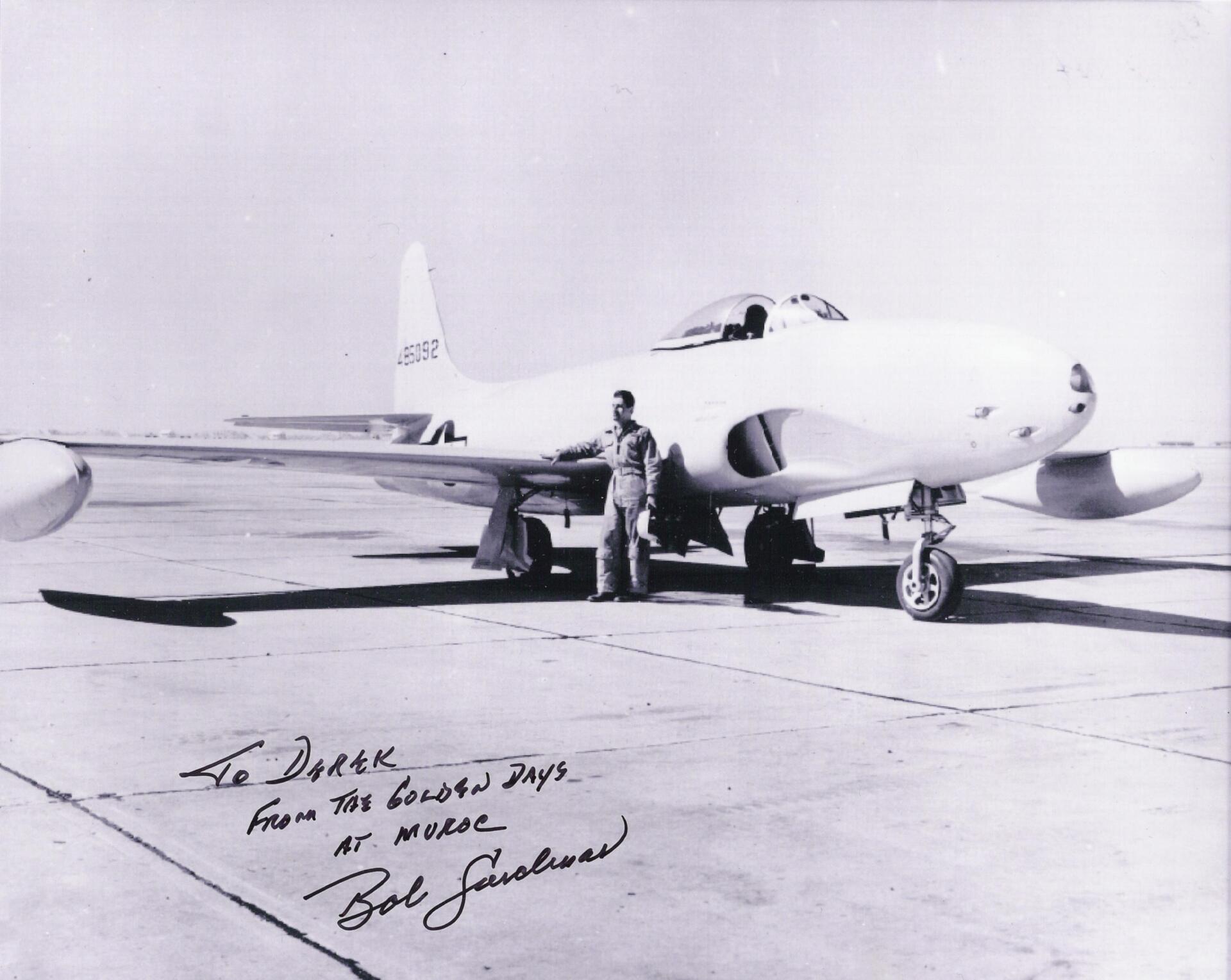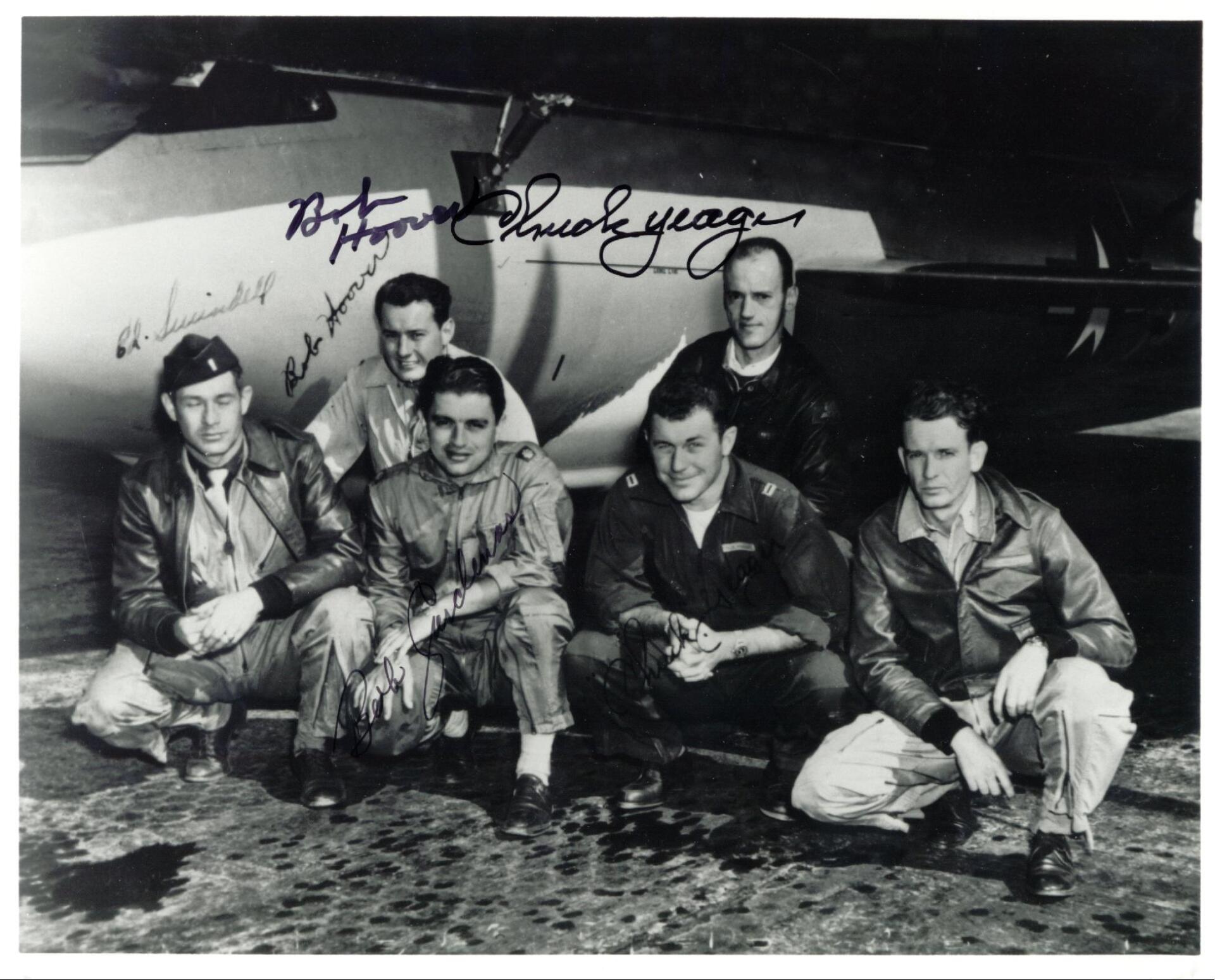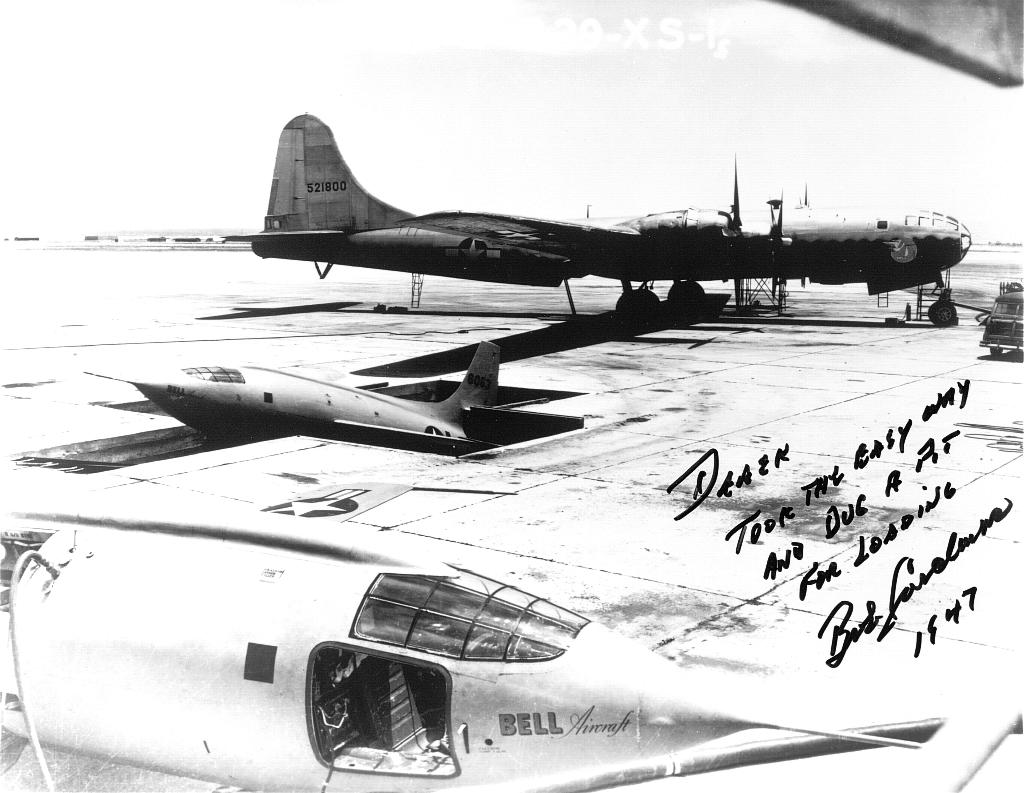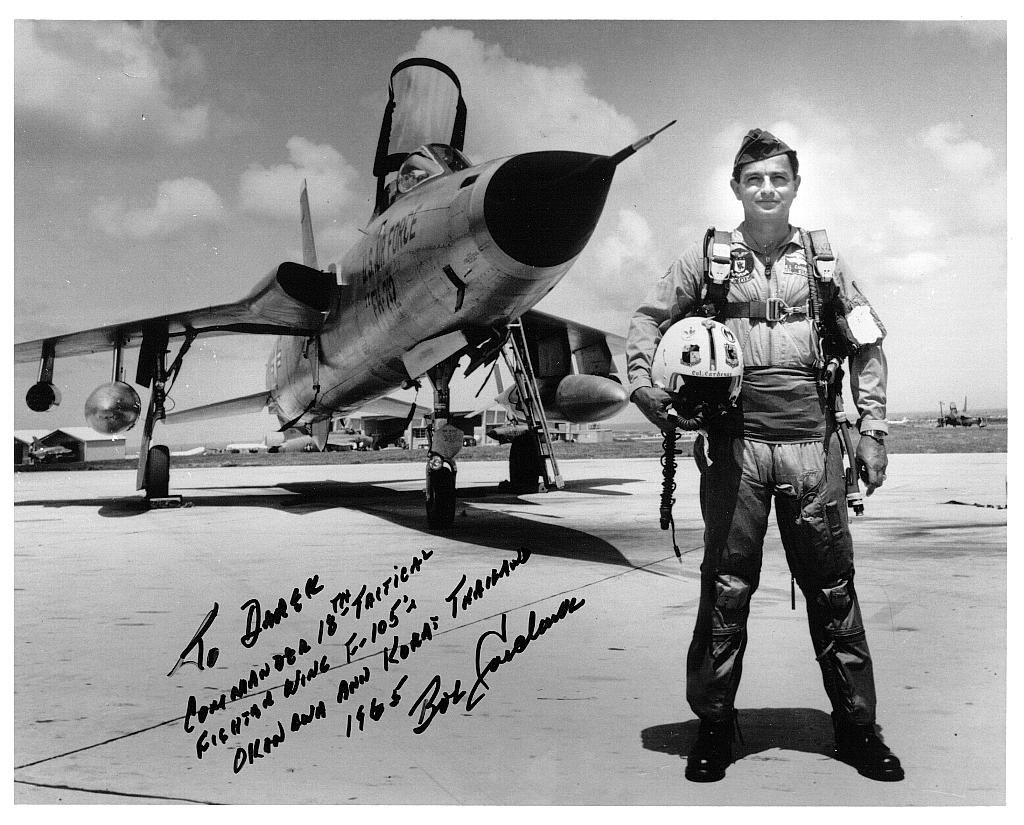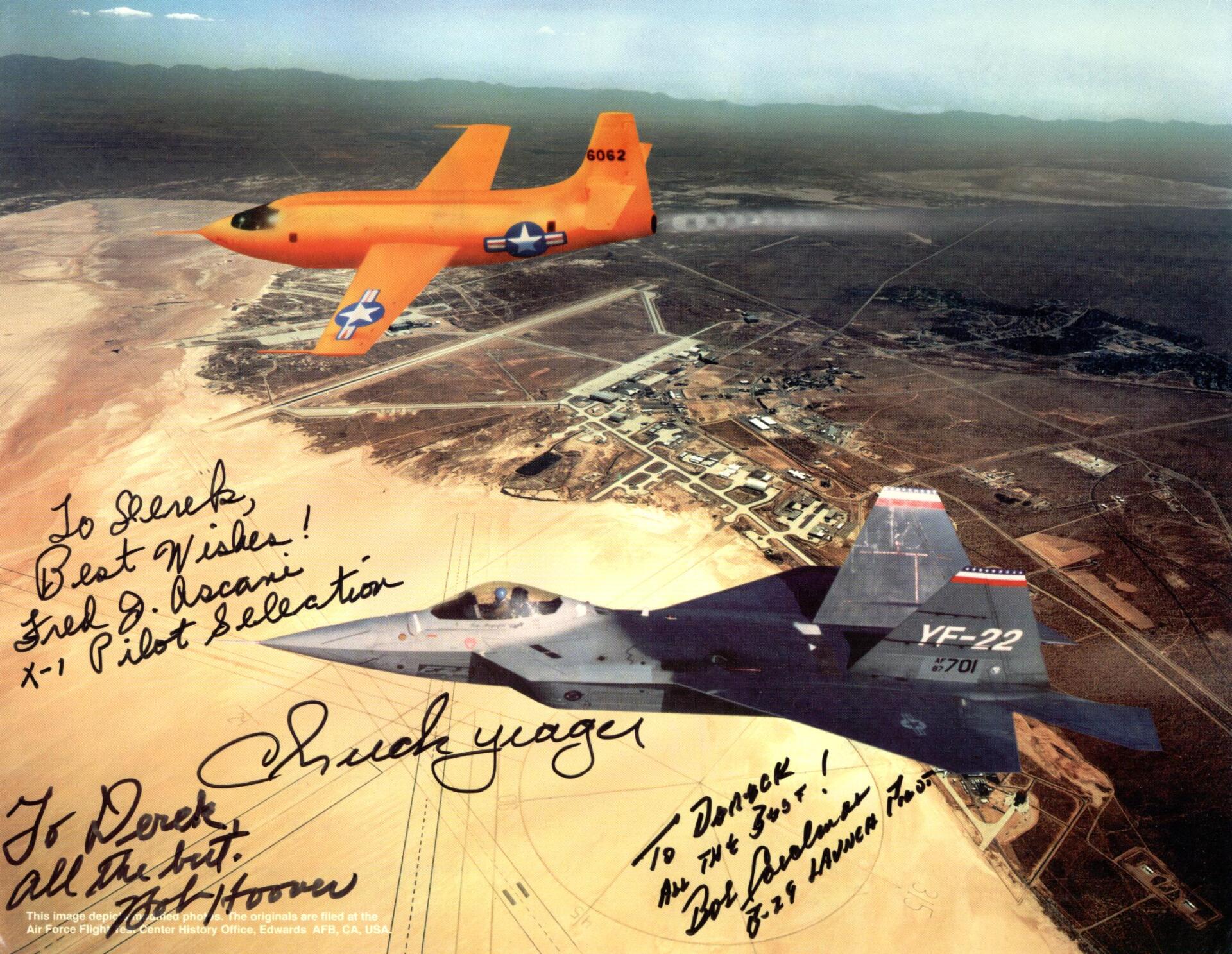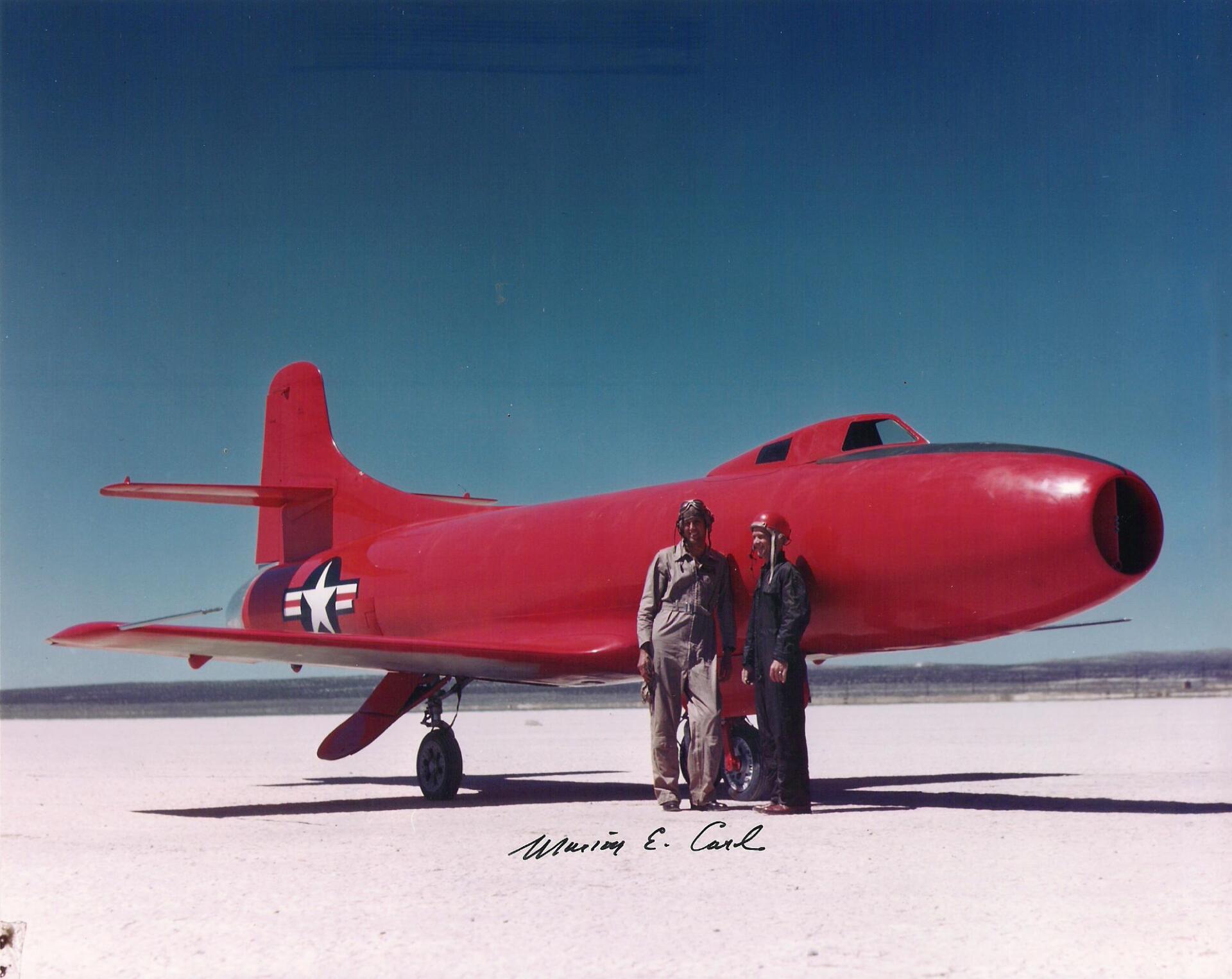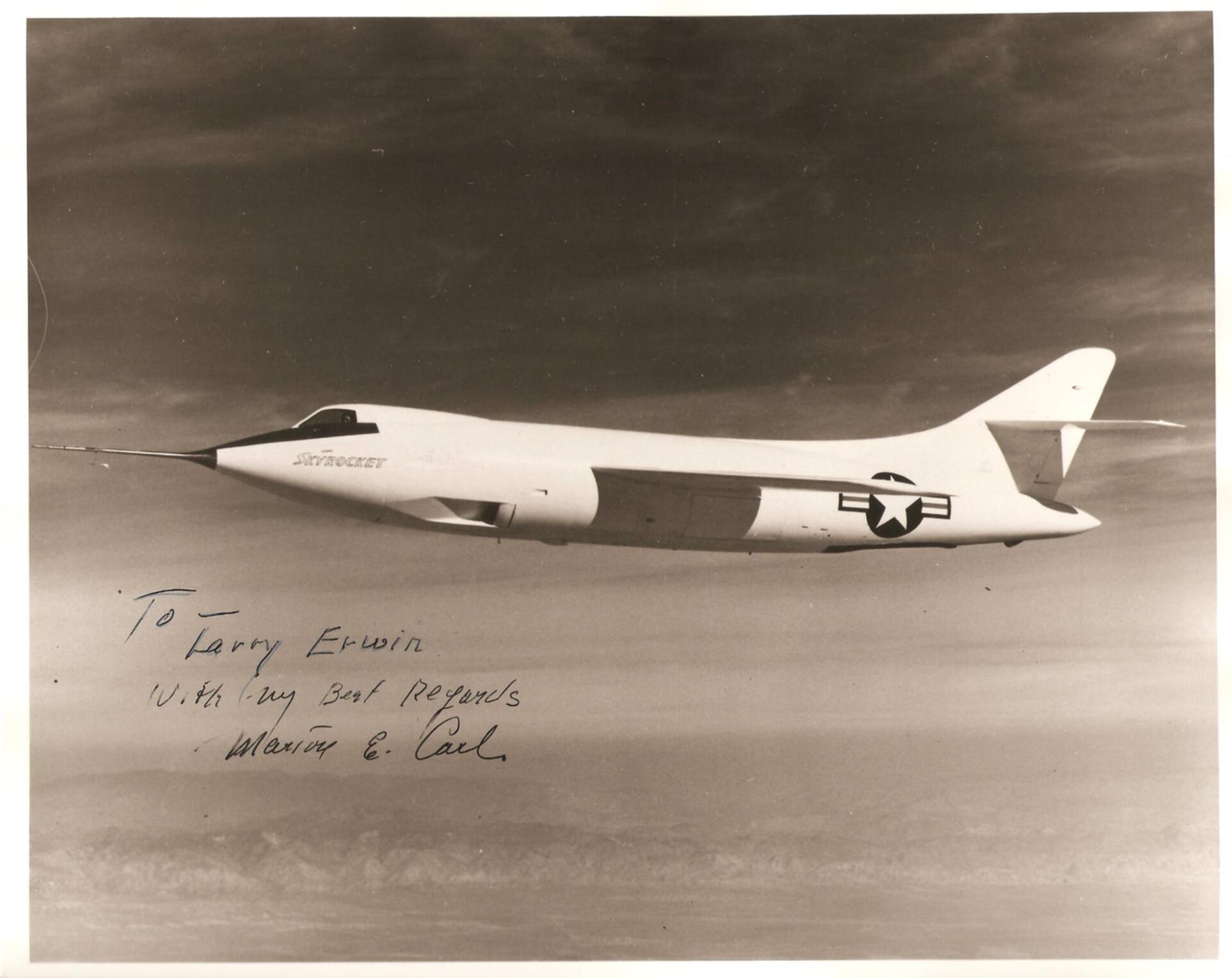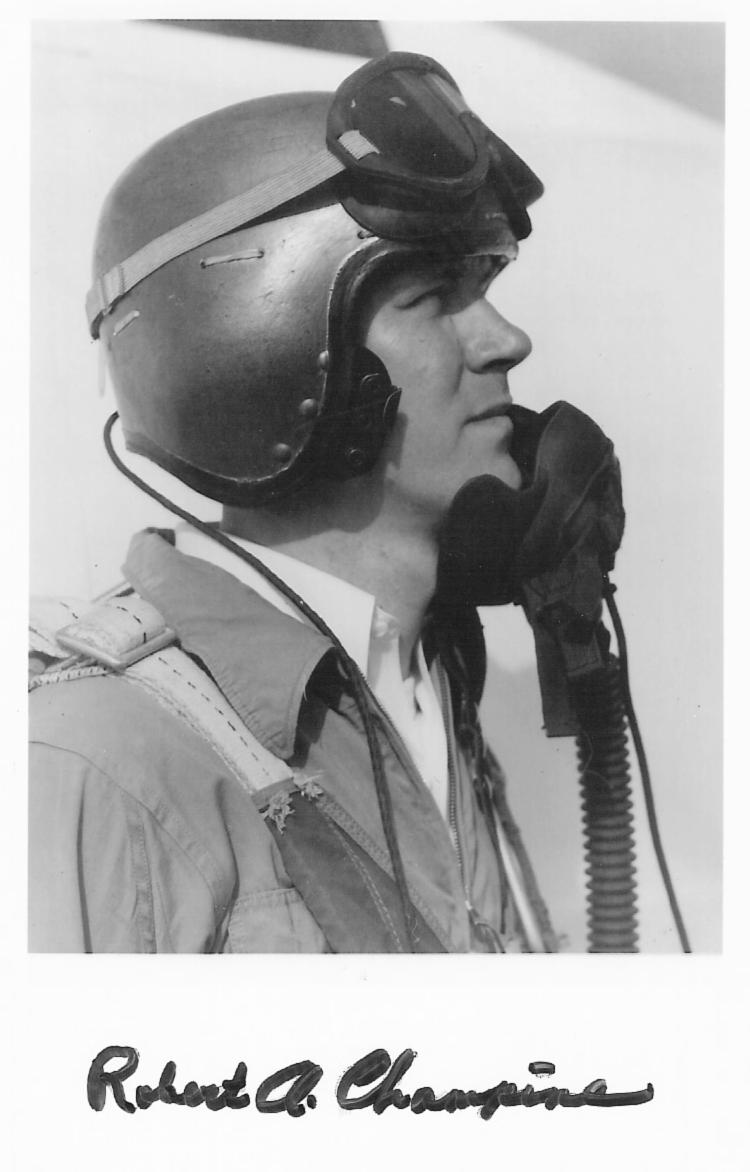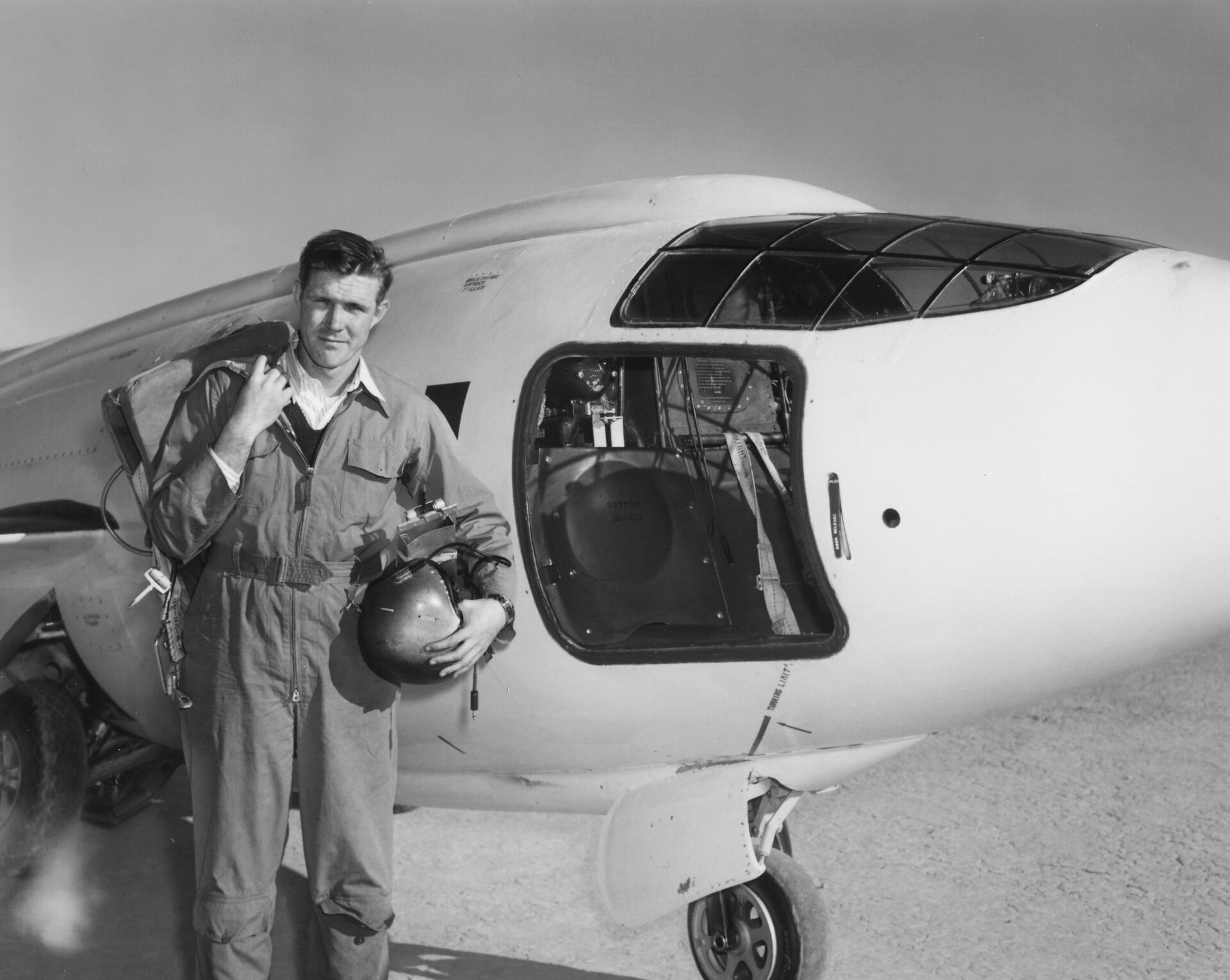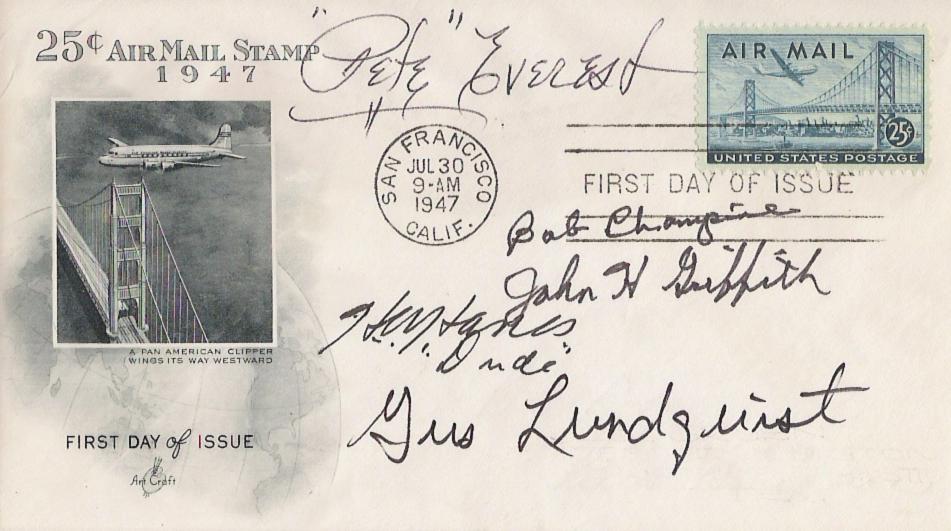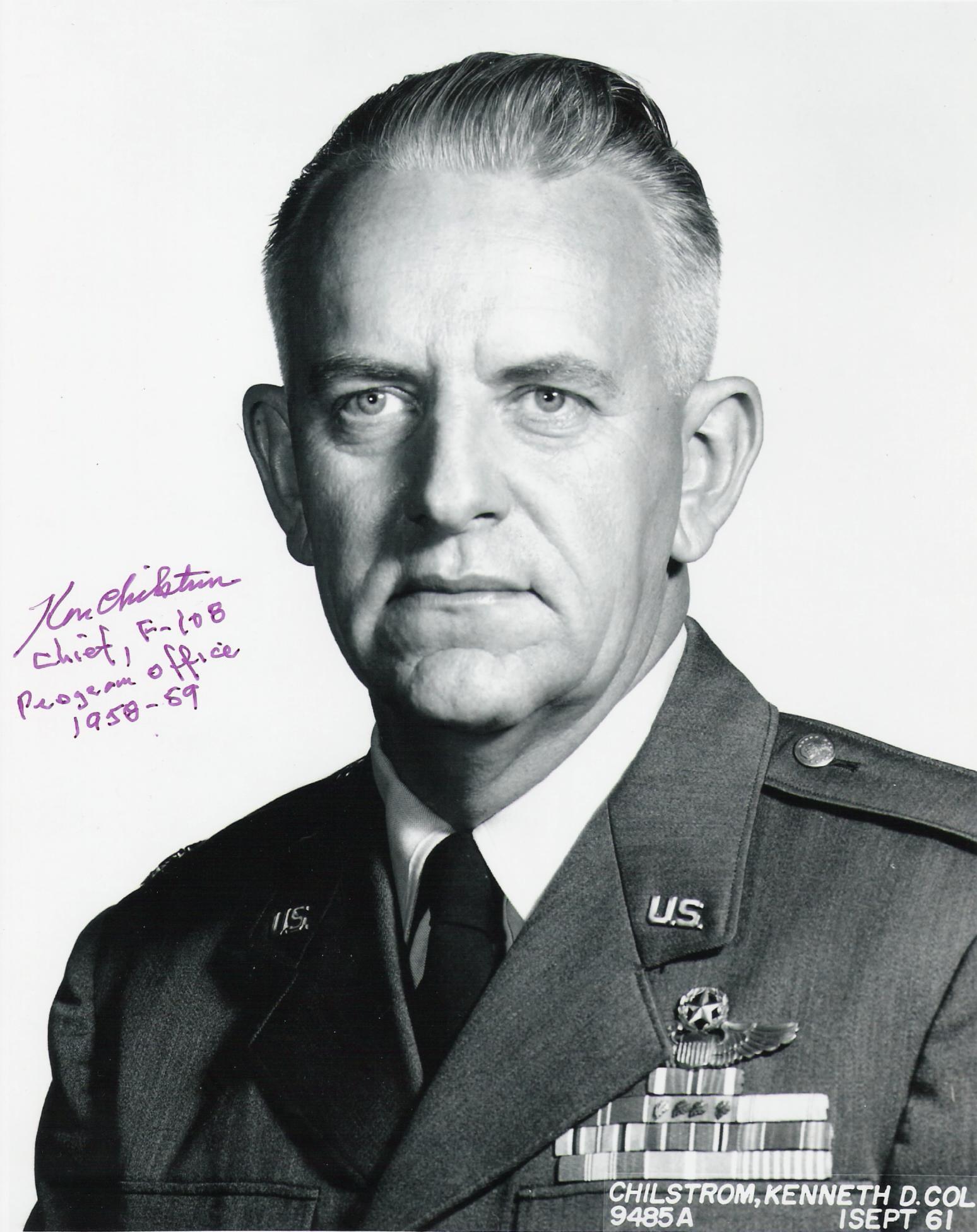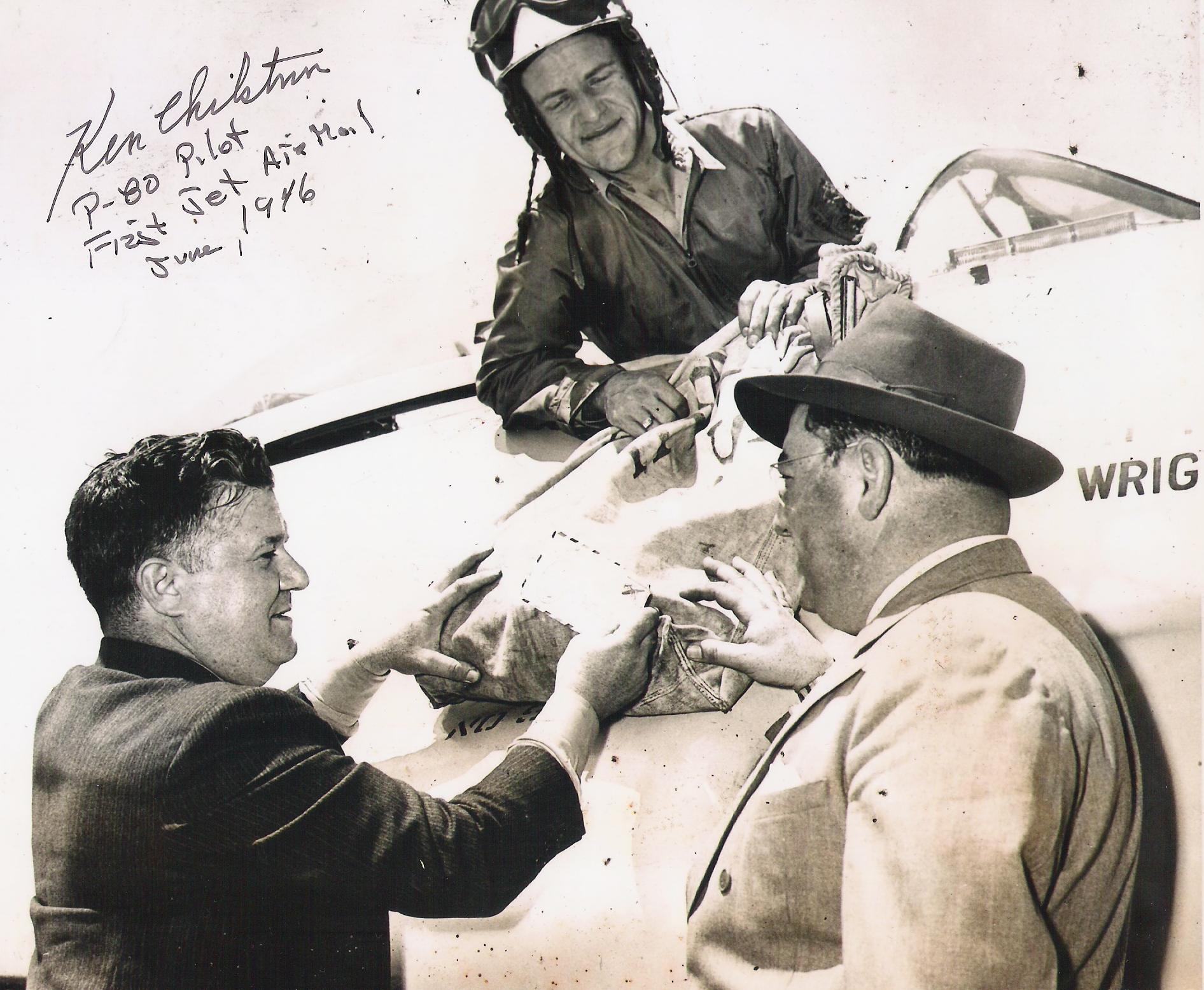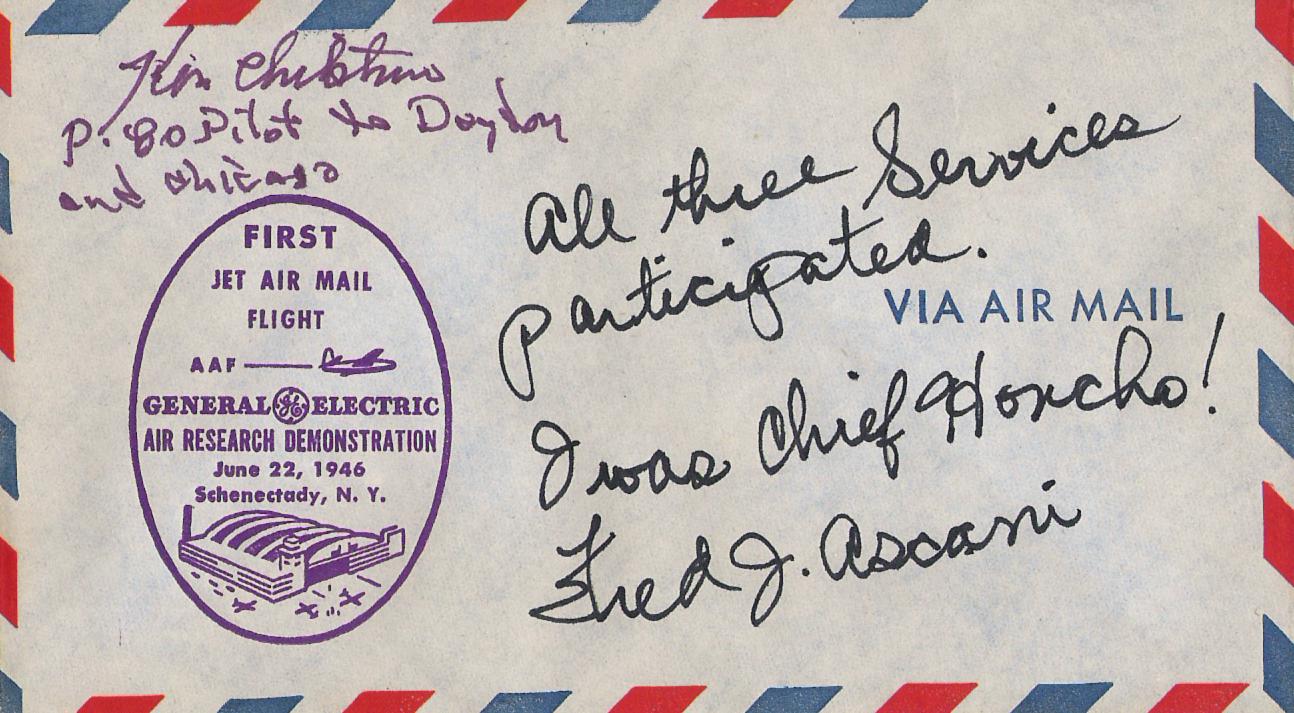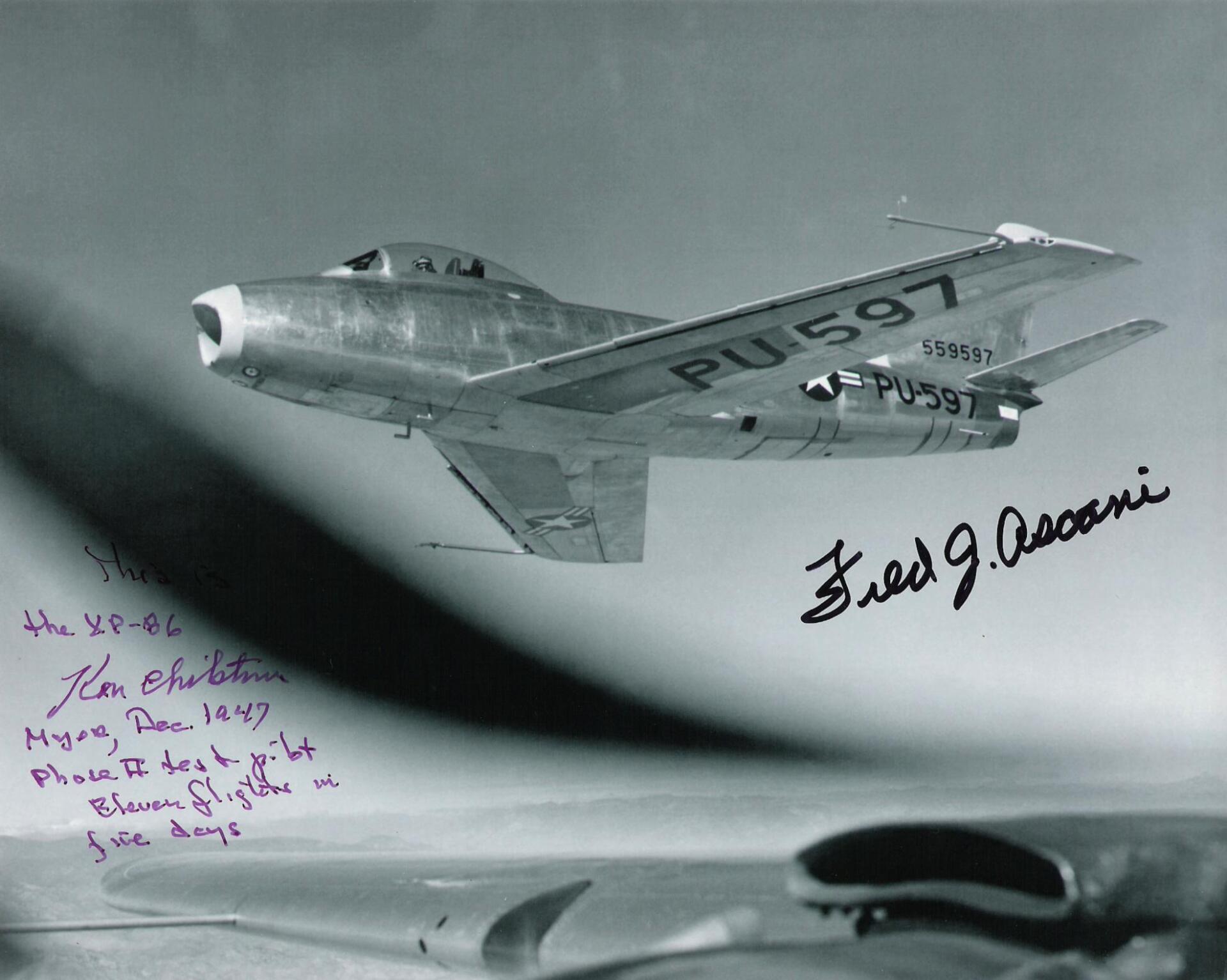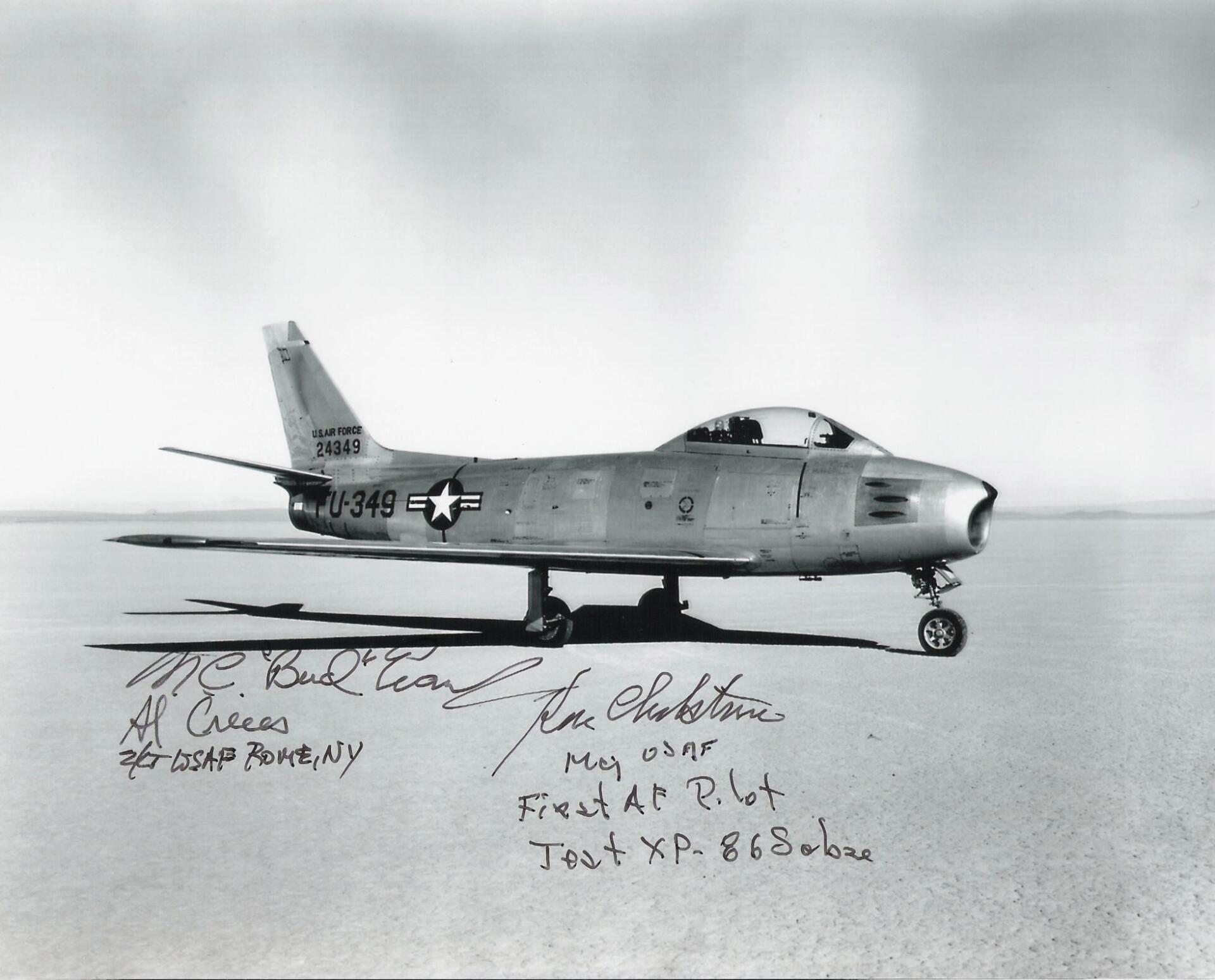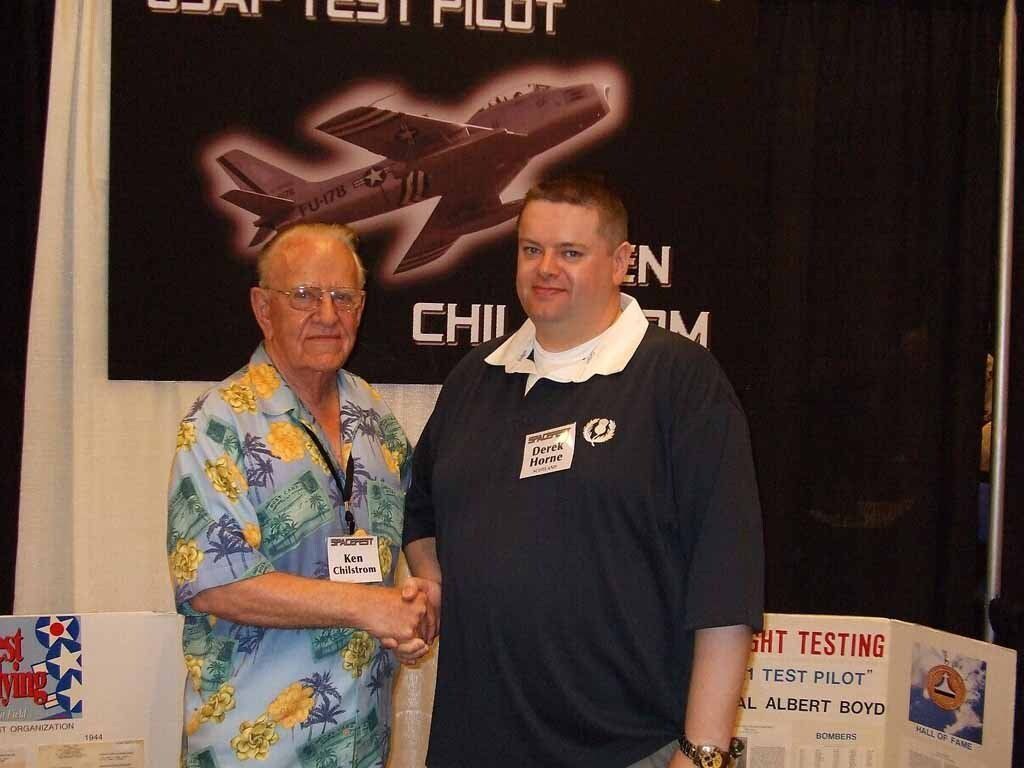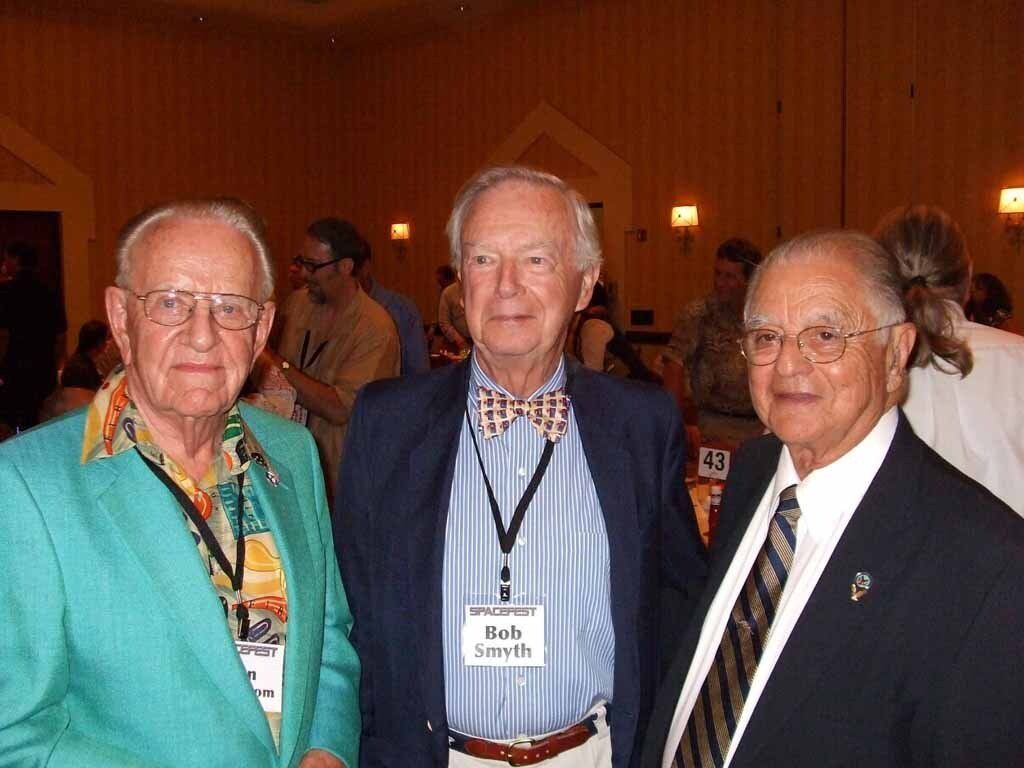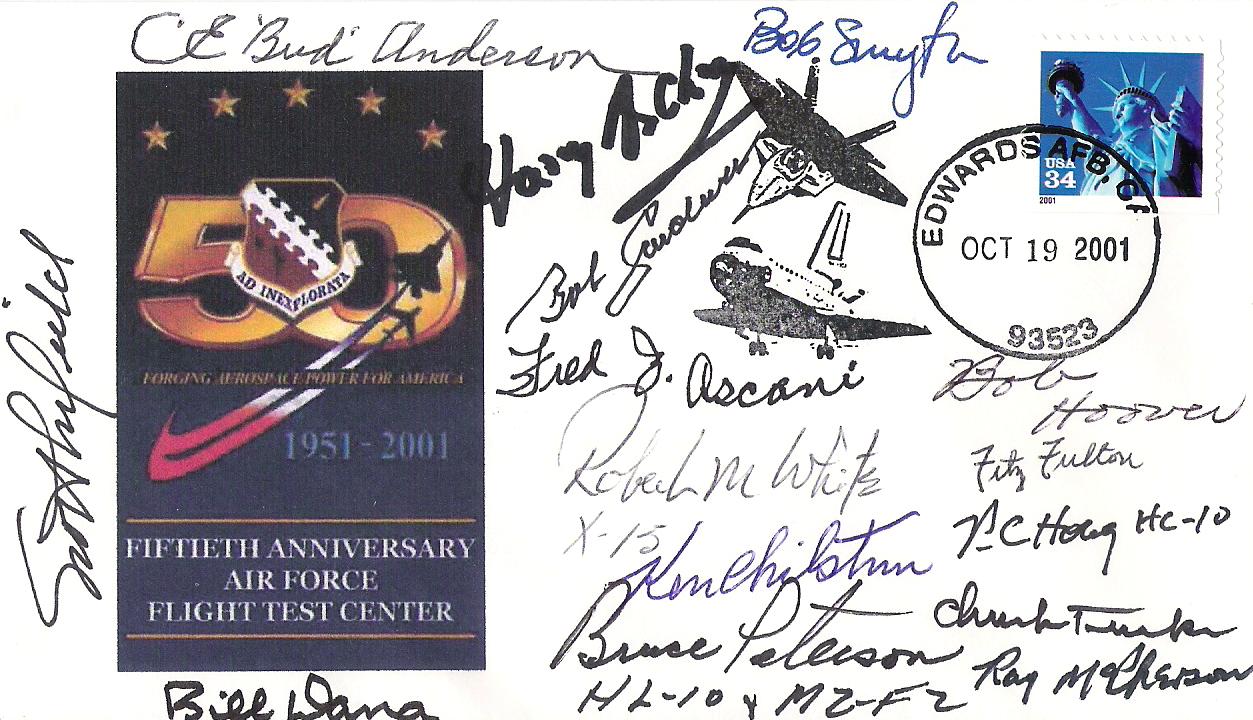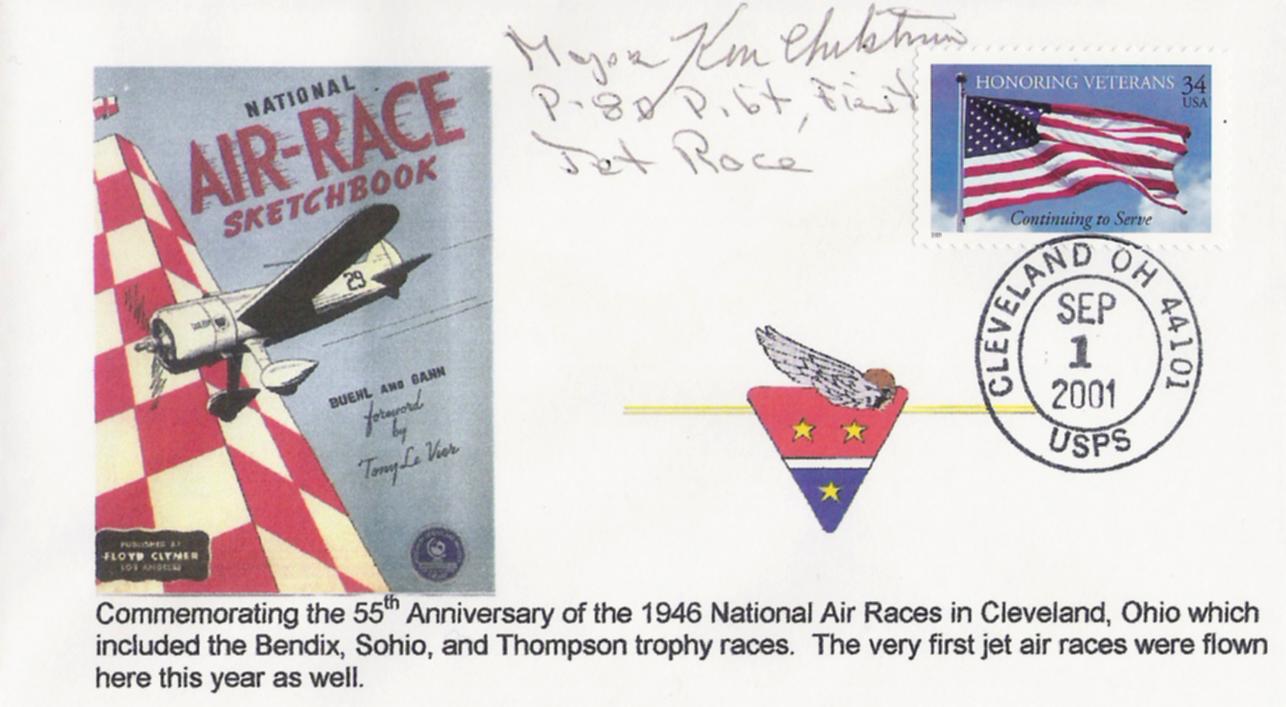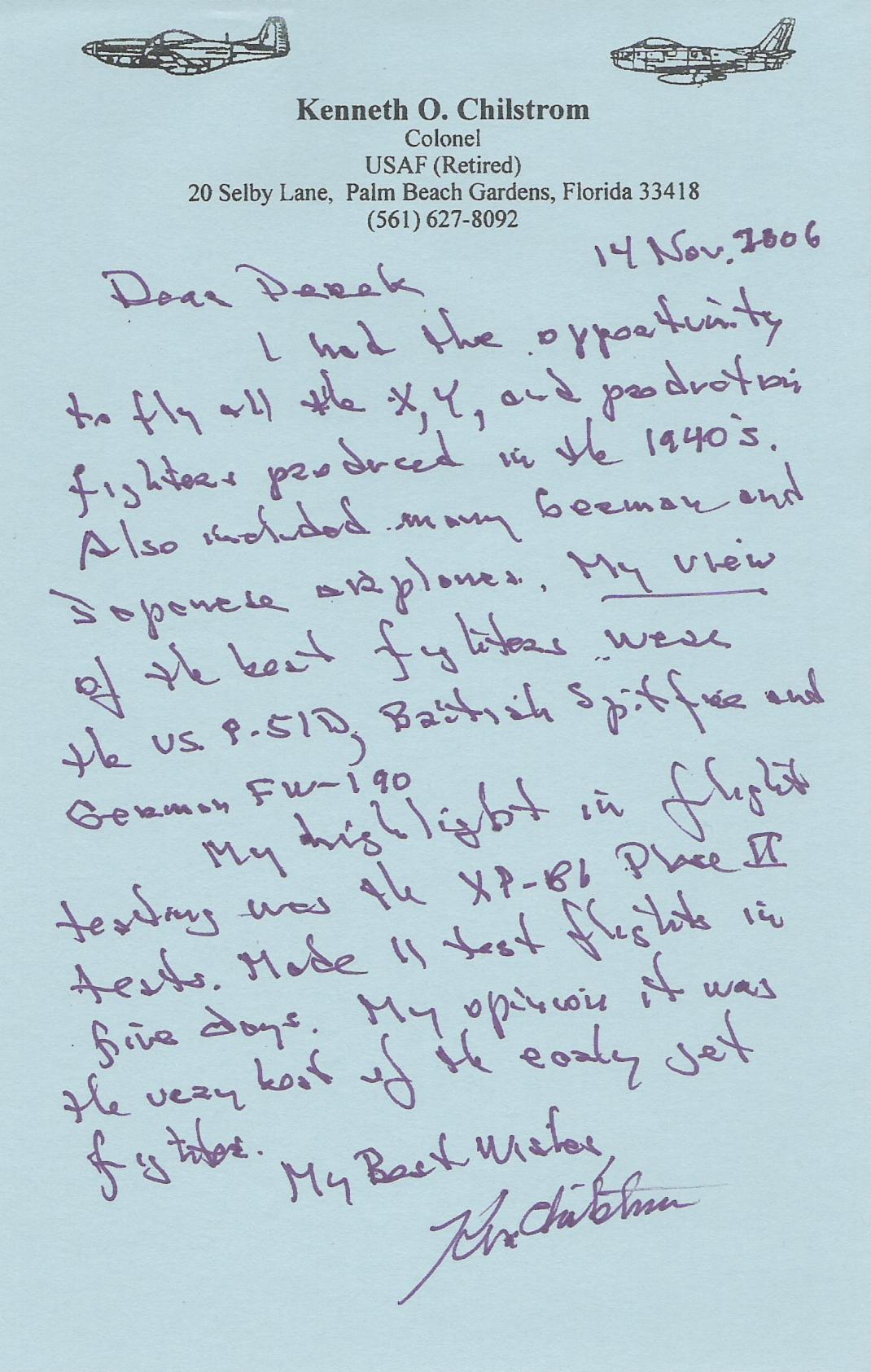Fred C. Bretcher - (1920-2004)
Fred Bretcher enlisted in the Army Air Corps in May 1941 as a Flying Cadet. He was in the first class to graduate from flight training (42A) after Pearl Harbour. Of the class of approximately 200, Bretcher was one of only three graduates assigned to the Wright Field Flight Test Section and became part of the first class of the "Test Pilot School". Most of the education was by flying as co-pilot with experienced pilots. Bretcher flew everything the Army Air Force had in their inventory; including the P-36, B-17, B-24, C-54 and XB-19.
While on temporary duty from Wright Field, Bretcher flew P-40, P-47 and P-51 combat missions in the European Theatre of Operations and visited the Royal Air Force to fly the Spitfire, Tempest and Lancaster.
Upon his return to Wright Field in 1944, Bretcher was assigned to the B-29 and then the B-32 program. He was promoted at that time to the rank of Major and became the Chief of the Bomber Flight Test Section. He also did quite a bit of test work at Muroc Army Airfield (now known as Edwards AFB). While there, he had his first experience flying the jet powered YP-59, YP-80A and the N9-M Flying Wing.
Bretcher joined Northrop as a test pilot in 1946 and built up his experience in the cockpit of the N9-M. He flew as co-pilot on the first flight of the XB-35, as pilot or co-pilot on the next two B-35's, as co-pilot on the first flight of the YB-49 and pilot of the first flight of the YRB-49 (with J.J. Quinn as co-pilot). He flew the first flight and Phase I tests of the XF-89 Scorpion and was co-pilot on the first flights of the N-23 and YC-125.
In 1950, he was transferred to Holloman AFB, New Mexico to head the flight portion of the Snark Missile Program. Bretcher retired from Northrop in 1952 and sadly passed away in June 2004, he was 83 years old. In the 3rd photograph in the above gallery, Bretcher can be seen at far right in sweat soaked clothes after the first flight of the XB-35.
William "Bill" Bridgeman - (1916-1968)
Bill Bridgeman was born in 1916 and grew up in southern California - photographs document him clowning around at Point Mugu in 1942. He flew B-24 bombers for the US Navy during World War II in Squadron VB-109 under Buzz Miller. His crew sunk the Japanese submarine RO-117, with 55 men aboard, on 17 June 1944. After the war he stayed in the Pacific, flying for several airlines. He obtained a bachelor of science degree from the University of California and became a test pilot for Douglas Aircraft in 1949. This led to pioneering flights on the D-558-2 rocket-plane and X-3 Stiletto in the 1950's. He was listed as an astronaut candidate for the US Air Force's Man In Space Soonest program in 1958 (NASA was created instead and given responsibility for putting the first man into space).
Bridgeman was briefly famous, setting altitude records, and appeared on a cover of Life magazine in 1951 as "The Fastest Man Alive". He later left Douglas and flew flying boats on the run from Long Beach to Catalina Island off Los Angeles. Alone on one of these flights, he crashed into the ocean, on 29 September 1968, and was killed instantly. At the time of his death Bridgeman was 52 years old and had flown 14,000 hours, 3,000 of them in the Grumman G-21 he was flying. Because he was such a superb pilot, many felt the crash in clear weather may have been due to a heart attack. The cause was never determined and his body was never recovered
Stanley P. "Stan" Butchart - (1922-2007)
After receiving primary and secondary civilian pilot training, Stan Butchart enlisted in the U.S. Navy in July 1942. Upon his completion of flight training at Corpus Christi, Texas, he joined torpedo-bomber Air Group VT-51 and flew the Grumman-General Motors TBM Avenger from the aircraft carrier San Jacinto in the South Pacific during World War II. He earned a Distinguished Flying Cross and a Presidential Unit Citation among other service medals. Butchart joined the NACA's High-Speed Flight Research Station as a research pilot on May 10, 1951. During his career as a research pilot, Butchart flew a great variety of research and air-launch aircraft including the D-558-I, D-558-II, B-29 (plus its Navy version, the P2B), X-4, X-5, KC-135, CV-880, CV-990, B-47, B-52, B-747, F-100A, F-101, F-102, F-104, PA-30 Twin Comanche, JetStar, F-111, R4D, B-720, and B-47.
Although previously a single-engine pilot, he became the Center's principal multi-engine pilot during a period of air-launches in which the pilot of the air-launch aircraft (B-29 or P2B) basically directed the operations. It was he who called for the chase planes before each drop, directed the positioning of fire rescue vehicles, and released the experimental aircraft after ensuring that all was ready for the drop. As pilot of the B-29 and P2B, Butchart launched the X-1A once, the X-1B 13 times, the X-1E 22 times, and the D-558-II 102 times. In addition, he towed the M2-F1 lightweight lifting body 14 times behind an R4D (Navy version of the C-47 and the DC-3). Among other awards, Butchart received the NACA Exceptional Service Medal for his decisions and actions when the X-1A exploded while attached to the B-29 launch aircraft on August 8, 1955. During his career, he wrote several technical reports and presented a number of research papers. He became one of 65 charter members of the Society of Experimental Test Pilots. He later was elected a Fellow of the Society and became its President in 1980. Mr Butchart passed away in October 2007. Read the full NASA biography of Stan Butchart . In the above photo gallery, the 4th photograph (1962 Dryden Pilots) was lost in the postal system coming back from Mr Butchart.
Brigadier General Robert L. "Bob" Cardenas USAF ret.
General Cardenas is a combat veteran of WWII where he flew B-24's for the 506th Bombardment Squadron (part of the 44th Bombardment Group). A test pilot at Wright-Patterson AFB and Muroc (later Edwards AFB), Cardenas flew the B-29 launch aircraft that carried the Bell X-1 rocket powered research airplane which then Captain Chuck Yeager flew beyond the sound barrier on October 14th, 1947 and was principal pilot on the Northrop YB-49 "Flying Wing" program. Read the full biography of General Cardenas on this website.
Major General Marion E. Carl USMC ret. - (1915-1998)
Marion E. Carl's aviation career was marked by pre-eminent accomplishments. A WWII Fighter Ace, he was among the first Marines to fly a jet and served as the Commander of the Navy's first jet fighter squadron (VMF 122). Carl was the first Marine to be designated a helicopter pilot and was the first military pilot to use a full pressure suit. Carl set the world speed record of 650.6 mph in 1947 in the Douglas D-558-I Skystreak at Muroc. He also set a world altitude record of 83,235 feet in the Douglas D-558-II Skyrocket in 1953. Carl served as Chief Test Pilot for all carrier type aircraft for four years. He performed experimental test flights in 30 different "X" model, propeller and jet aircraft.
Carl flew 260 different types and models of aircraft and when he retired in 1973 he had 14,000 flying hours in his form 5. Aircraft tested by Carl include, XF-8F, XBTK, XBT2C, XBTC, XF-15C, XBTM, XHOS, XFJ, XFD, XF-7U, XF-8B, XF-3D, XHO3S, XF-4D, F-7F Series, ME-262, HNS, F-2G, F-8F, F-6U, F-2H, AF, FJ, P-59, P-80, D-558-I, D-558-II and the F-9F Series. Carl received Naval Air Test Pilot Training at the Naval Air Test Center. He has been honored with the Octave Chanute Award, Naval Carrier Aviation Test Pilot's Hall of Honor, Naval Aviation Hall of Honor, two Navy Crosses, five Distinguished Flying Crosses for significant achievement in experimental test flying, fourteen Air Medals, four Legion of Merit Awards and the City of Lancaster's Aerospace Walk of Honor in 1992. Sadly Marion Carl was slain on June 28th, 1998 in his Roseburg home while defending his wife, Edna, from a shotgun-wielding burglar. He was 82.
Robert A. "Bob" Champine - (1921-2003)
Robert A. Champine was a research pilot with the National Advisory Committee for Aeronautics (NACA) and the National Aeronautics and Space Administration (NASA) from December 1947 to 1979, when he retired as Langley Research Center's senior research pilot. He began his career with the NACA at the Langley Memorial Aeronautical Laboratory in Hampton, Virginia (as Langley Research Center was then called). He transferred to the NACA's High-Speed Flight Research Station in the Mojave Desert of California in October 1948, where he flew the X-1 and D-558-I and -II research airplanes.
On December 2, 1948, Bob became the 6th man and 3rd civilian to break the mysterious sound barrier. He exceeded Mach 1 on NACA flight 23 checking handling qualities and pressure distribution on the XS-1 #2, after having been dropped from the B-29 mother ship, above the Rogers Dry Lake in California. On August 4, 1949, NACA flight 32, he again exceeded Mach 1 performing rolls, pullups, sideslips, and check of stabilizer effectiveness. This was his 13th and last flight in the XS-1. He flew the first NACA research flight of the D-558-I #3 (Skystreak) on April 22, 1949, and the first NACA research flight of the D-558-II #2 (Skyrocket) on May 24, 1949, beginning the supersonic research program for these aircraft on June l, 1949. Please read the full NASA biography of Bob Champine. Sadly Bob Champine passed away in 2003.
Colonel Kenneth O. "Ken" Chilstrom USAF ret.
Colonel Chilstrom is a combat veteran of WWII flying 80 missions in the North African campaign during 1943. Flying with the 27th Fighter Bomber Group, Colonel Chilstrom flew the A-36 on dive bomb and strafing missions and won the DFC and Eight Air Medals. After rotating back to the USA, Chilstrom was assigned to Wright Field, Dayton Ohio as a test pilot. Chilstrom flew flight test evaluations of the captured ME-109, FW-190 & ME-262. On February 17, 1945 Colonel Chilstrom was the first US pilot to have a major accident in the Bell P-59 (America's first jet aircraft) when he lost power on take-off. In 1946, Chilstrom participated in the first jet air race at the National Air Races in Cleveland, OH. The winner of that race was Captain Gustav E. Lundquist.
In September 1946, Chilstrom became Chief pilot of the Fighter Test Division at Wright Field and under his charge were some of the most famous test pilots in US history including, Pete Everest, Dick Johnson, Chuck Yeager and Bob Hoover. In 1948 Chilstrom flew the Phase II tests of the XP-86 program at Muroc AFB, CA. Chilstrom was promoted to the rank of Colonel in 1958 and that year was assigned as the Project Manager of the North American XF-108 Rapier at Wright Field. The XF-108 was to have been a Mach 3 long range interceptor but this program got sadly cancelled to save the sister XB-70 program due to a budget funding shortfall. Colonel Chilstrom retired from the USAF in 1964 after 26 years service and after 22 years of working for civilian defence contractors retired in 1986 to Palm Beach, FL. Expanded biography of Ken Chilstrom.
I've had the privilege and honor of knowing Colonel Ken Chilstrom for over 20 years and met him at "Space Fest" in Arizona in August 2007 when myself and some like minded Flight Test history enthusiasts sponsored his attendance.
